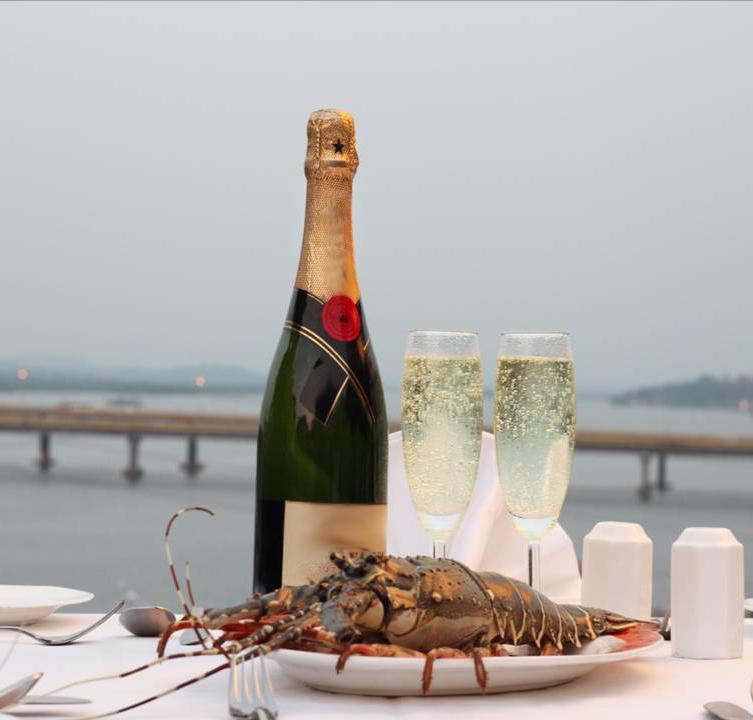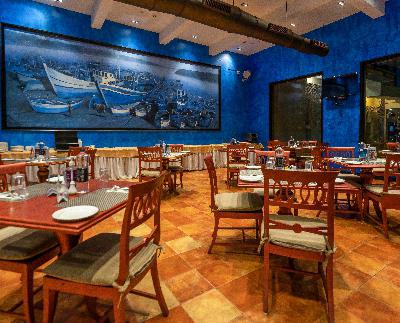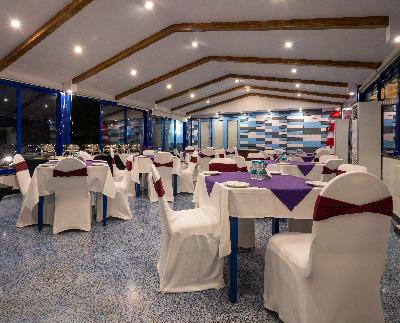

SMALL PLATES BIG PRICES
The Rise of Tapas-Style Dining in Goa









“Goa, Like You've Never Seen Before.”
Beyond beaches. Beyond clichés. Your real Goan journey begins here
COMING SOON
The ultimate travel guide that's made in Goa, for the world.


TRAVELTALES
© All rights are Reserved. Reprinting, publishing whole or part without obtaining the express written permission of editor and publisher is strictly prohibited. All the images unless otherwise indicated are used for illustration purpose only. In case you feel that any image/s or content/s should not be there / needs due credits / having copyrights, you may please immediately inform the same to the editor/publisher in written format, the needful will be done in the following issue.
To err is human. Although we take due care while publishing the magazine to ensure it is free of any mistakes, any omissions or errors are entirely unintentional. In case you find any erroneous photographs, language, missing credits or anything else published incorrectly, please feel free to bring it to our notice. We believe in publishing matters that catch our readers' attention and at the same time impart information. We hope all our readers appreciate the content and help us make this publication even better and more useful.
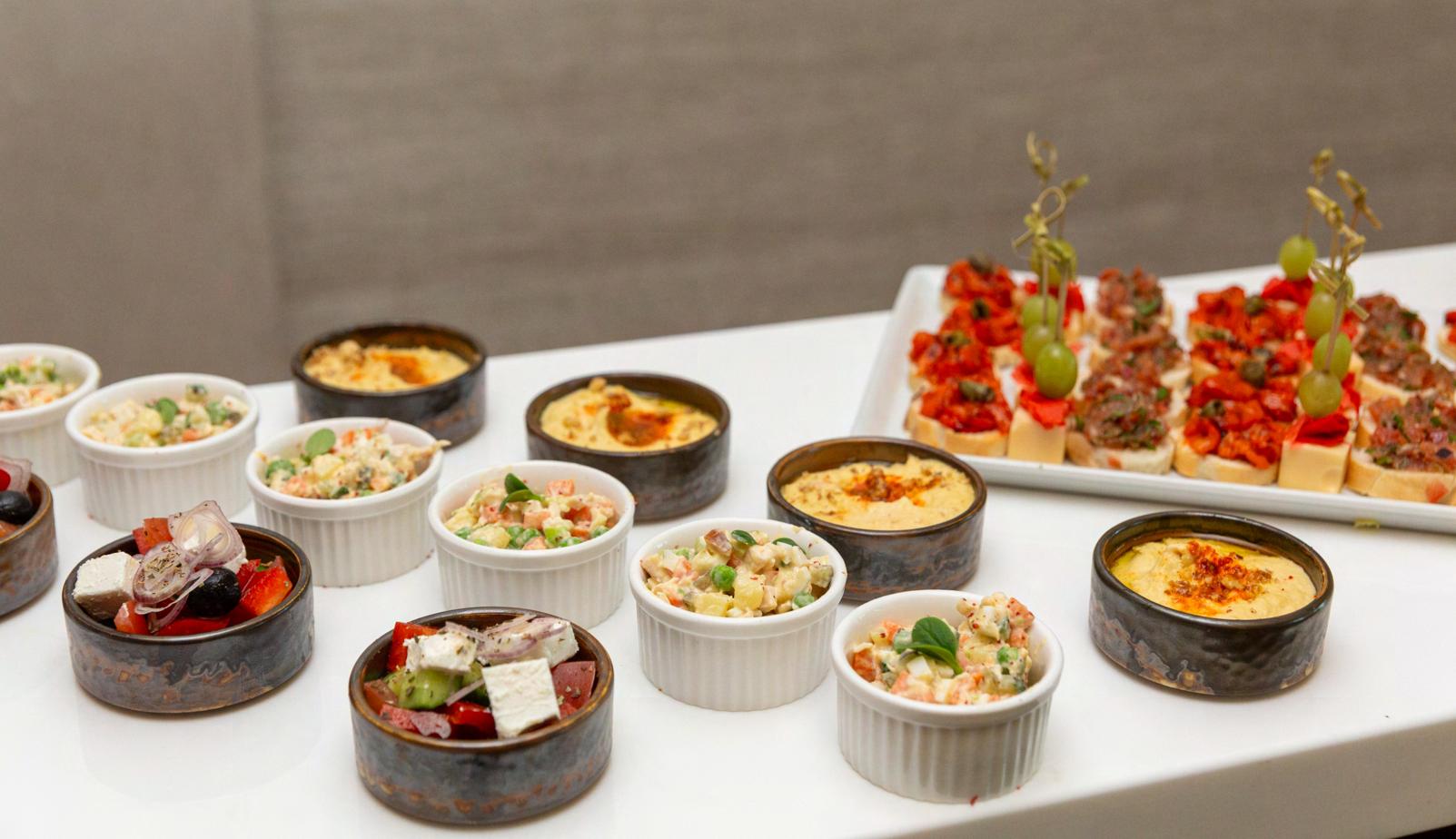



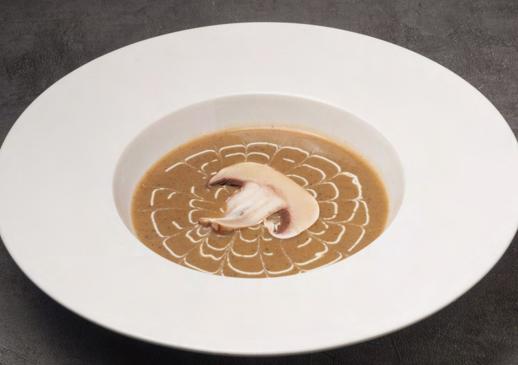






ADITI MALHOTRA MANAGING EDITOR
A SEASON FOR SAVOURING
Hello,dearreaders!
Summer in Goa doesn’t creep in—it arrives all at once. The mornings stretch longer, the breeze turns warm and salt-kissed, and the rhythm of life subtly shifts. There’s a certain pause in the air, not the stillness of quiet, but the stillness of settling in—a reminder that this is a season not meant to be rushed.
Everywhere you look, the signs of summer unfold: fruit-laden tables, cool clay bottles sweating gently in the shade, chatter that moves from sunlit verandas to breezy balconies. It’s not the kind of season that demands extravagant plans—it simply asks you to be present. To taste more slowly, rest moreoften,andenjoywhat’srightinfrontofyou.
And maybe that’s the real essence of this time—making space for what brings ease. For food that doesn’t weigh you down but still comforts. For small discoveries—a new place, a forgotten ingredient, a quiet moment you didn’t realise you needed. For slowing down, not because you're lazy, but because you're finally listening to your body and theseason.
In many ways, summer teaches us the joy of simplicity. The power of well-paired flavours. The calm of slow mornings and light dinners. The beauty of pausing before the year rushes on again. And as the sun pours its golden insistence over our days, perhaps we’re reminded that this too is a time to celebrate—notwithnoise,butwithintention.
Sowhetheryou’rereadingthisfromasun-drenched café corner, between weekend plans, or while sipping something chilled and citrusy, we hope this issue brings you exactly what the season is asking for—inspiration, flavour, and a little more time to savouritall.
Untilnexttime,staycoolandstaycurious. Cheers
Withloveandlight,
Aditi
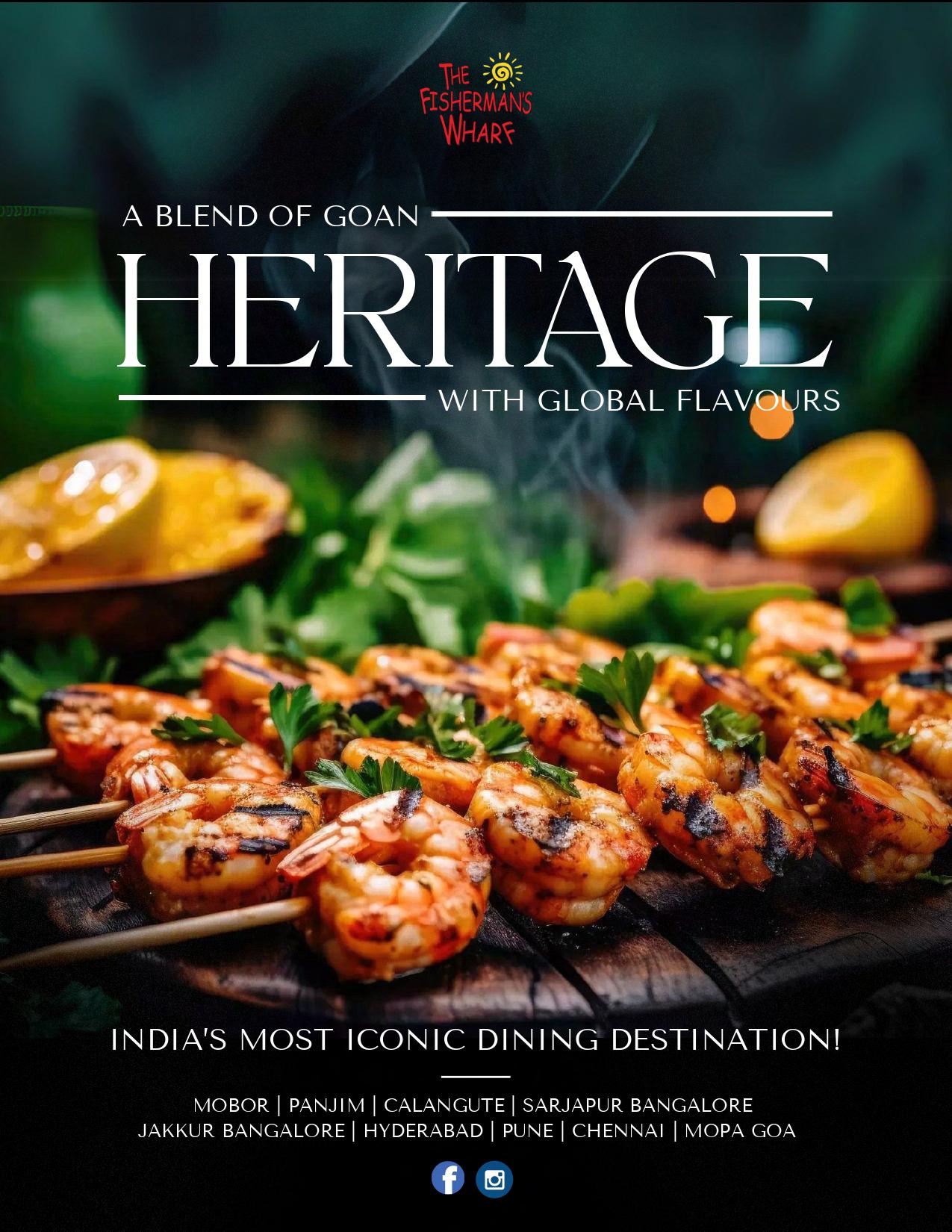
THE TEAM

Editor in Chief & Publisher
Rajesh Ghadge rajesh@rajeshghadge.com
Managing Editor
Aditi Malhotra aditi@foodandhospitality.org
Contributors
Sunil Malhotra
Armaan Malhotra
Aakash Ghadge
Gauri Ghadge
Niharika Sachdeva
Saloni Pai
Design & Layouts
GPDM - A Media Company info@goaprism.com
Photography
Tanmayee Masurkar
Gauri Ghadge
Aakash Ghadge
EDITORIAL OFFICES
2nd Floor, Udyog Bhavan, Opp Azad Maidan, Panaji,Goa-403001

2nd Floor, Udyog Bhavan, Opp Azad Maidan, Panaji,Goa-403001 +91 8999085172 | info@foodandhospitality.org

SUBSCRIPTIONS & ADVERTISEMENTS
+91 8999085172 | info@foodandhospitality.org
The Magazine is Published by GOA PRISM DIGITAL MEDIA Rajesh Ghadge, RNI - GOAENG/2020/00441 www.fnhmag.com
2nd Floor, Udyog Bhavan, Opp Azad Maidan, Panaji,Goa-403001
Cover Photo Credits
Image by Freepik Stock Images Credits FNH TEAM
@foodandhospitalitymagazine


BHAKTI KALSEKAR
To Lead J Wellness Circle atTaj Cidade de Goa as Spa Manager

Taj Cidade de Goa, one of the most iconic beachfront luxury hotels in Goa, has announced the appointment of Bhakti Kalsekar as the new Spa Manager, where she will lead the esteemed J Wellness Circle—a sanctuary of tranquility, rooted in ancient Indian healing traditions and modern therapeutic techniques.
With a remarkable career spanning over 20 years, Bhakti brings a wealth of experience and a holistic vision for wellness that aligns perfectly with the ethos of the Taj brand. Her appointmentmarksanewchapterintheproperty'sdedication
to offering transformative spa experiences tailored to the individualneedsofeachguest.
BhaktiKalsekarholdsapostgraduatediplomain cosmetology, making her a seasoned expert in beauty and skincare treatments. Additionally, she is a certified yoga instructor, bringing together the best of physical, mental, and spiritual wellness practices under one roof. This rare combination of skills positions her to offer an integrated wellness approach thatgoesbeyondtraditionalspaofferings.
Her vast experience in managing luxury wellness operations across India has equipped her with a strong operational acumen and an innate understanding of customer expectations. Known for her leadership skills, sharp attention to detail, and ability to multitask seamlessly, Bhakti has consistently delivered excellence across all her professional roles. Her career journey reflects her deep-rooted passion for healing, mindfulness, and guest personalization—key pillars that now define her vision for the J Wellness Circle at Taj CidadedeGoa.
Speakingonherappointment,Bhaktishared, “I'mtrulyhonouredtojoinTajCidadedeGoaasSpaManager. This iconic property embodies wellness, and I look forward to curating holistic experiences that nurture the body, mind, and soul. Together with my team, I aim to elevate our guests' journeytorelaxationandrejuvenation.”
Under Bhakti's leadership, the J Wellness Circle is poised to evolve as a premier destination for wellness seekers. From bespoke Ayurvedic therapies to mindfulness rituals, yoga programs, and modern rejuvenation techniques, every offering is designed to inspire a sense of inner peace and outer glow. Her approach is firmly grounded in the philosophy of integrated well-being—where traditional Indian healing meetscutting-edgespascience.
Taj Cidade de Goa has long been recognized for its immersive hospitality and serene coastal setting. With Bhakti now at the helm of its wellness operations, the resort is set to further elevate its standing as a sanctuary of wellness in Goa. The J Wellness Circle is not just a spa—it is an experience that embodies the Taj's commitment to luxury, mindfulness, and authenticIndianhospitality.
Bhakti's vision aligns perfectly with the growing global demand for conscious travel and personalized wellness. As she brings her wealth of knowledge and nurturing spirit to Taj Cidade de Goa, guests can look forward to deeply rejuvenating and thoughtfully curated wellness journeys—each one a reflection of her passion, purpose, and precision.





Where the Sea Comes to Your Table COPPERLEAF GOA
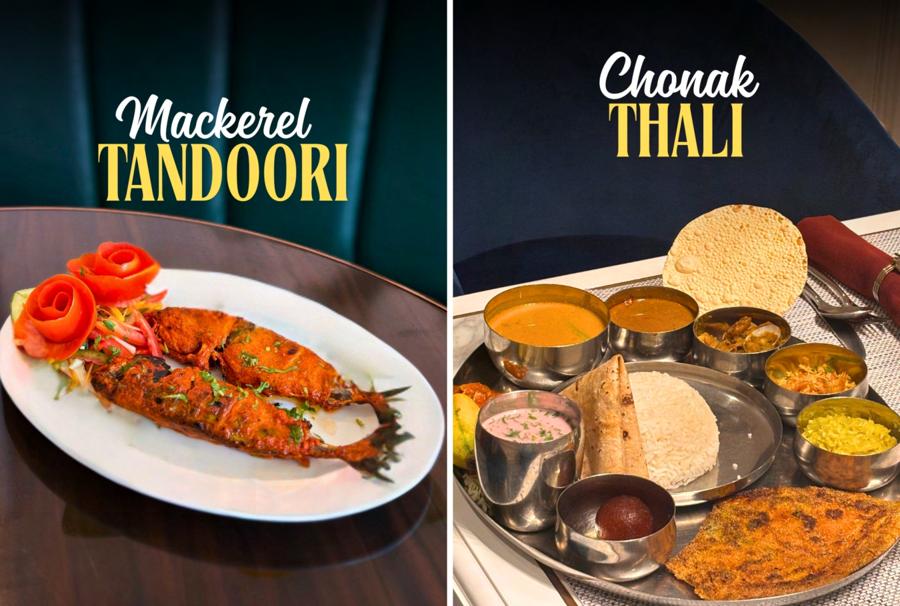
In Goa, seafood isn’t just a dish—it’s an identity. It’s woven into the coastal rhythm of life, simmering in spices, sizzling in pans, and savoured with stories passed down through generations. Amidst a landscape brimming with beachside shacks and luxury eateries, one name consistently rises above the tide—Copperleaf. This revered restaurant has redefined what it means to enjoy seafood in Goa, marrying authenticity with elegance to offer a dining experience that’s as soulful as it is sophisticated.
Tucked away in the bustling heart of Porvorim, Copperleaf is far more than just a restaurant—it’s a destination for those who revere the fruits of the ocean. From the moment you step in, you’re greeted by an ambience that balances the charm of Goan hospitality with refined contemporary design. But the true star, of course, is what arrives atyourtable.
Every dish at Copperleaf is a tribute to Goa’s deep-rooted culinary heritage. The Chonak Rawa Fry arrives crisp and golden, delicate in flavour and yet powerfully evocative. The Recheado Pomfret, stuffed with a fiery red masala, channels the intensity and depth of traditional Goan kitchens. And then there's the Prawns Curry with Rice—humble, hearty, and comforting, served just thewaylocalshavesavoureditfordecades. What elevates Copperleaf from excellent to exceptional is its commitment to freshness and
tradition. The seafood is sourced daily from local markets, ensuring that every bite is brimming with ocean-fresh flavour. Spice mixes are ground inhouse, carefully blending age-old recipes with a chef’s instinct for balance. This respect for ingredients and authenticity is what keeps patrons—bothGoanandglobal—comingback. No visit to Copperleaf is complete without indulging in their iconic Seafood Thali—a lavish, multi-dish spectacle that encapsulates the spirit of Goan cuisine. From Crab Masala and Tisryo Sukem to fried fish, tangy Sol Kadi, and velvety curries,eachcomponentismeticulouslyprepared, offering a curated tasting of the region’s coastal bounty. The thali is not just a meal—it’s a cultural immersiononaplate.
But Copperleaf’s allure isn’t limited to its menu. It’s in the details—the impeccable service, the inviting décor, the thoughtful presentation, and the seamless blend of comfort and class. Whether you're enjoying a quiet weekday lunch or hosting an intimate celebration, the experience is consistently warm, memorable, andfilledwithflavour.
In a state where culinary excellence is as much a tradition as a trend, Copperleaf stands as a beacon of quality, consistency, and culture. It is where the sea meets the soul, where every meal tells a story, and where seafood is honoured with the reverenceittrulydeserves.



INDUSTRY BUZZ

HOLIDAY INN NEW DELHI MAYUR VIHAR NOIDA UNVEILS STYLISH AND SUSTAINABLE RENOVATED ROOMS
In a significant step towards enhanced guest experience and eco-conscious hospitality, Holiday Inn New Delhi Mayur Vihar Noida has officially unveiled its newly renovated rooms, blending timeless elegance with modern sustainability and smarttechnology.
The redesign reflects the hotel’s forward-thinking vision—a sophisticated upgrade tailored for today’s discerning traveller who values both comfort and environmental responsibility. Each room has been meticulously transformed with premium materials and intelligent systems to create a serene, high-performance living space.
HIGHLIGHTS OF THE RENOVATION INCLUDE
Premium Belgian Hardwood Flooring: Elevates the overall aesthetic with a refined, natural finish.
Eco-Friendly Fixtures: Water and energy-saving taps and showers emphasize a strong sustainabilitycommitment.
Next-Gen Climate Control:
Integration of BLDC motor technology in air-conditioning for improved energy efficiency andconsistentcomfort.
Complete MEP Overhaul: A full upgrade of mechanical, electrical, and plumbing systems for greater operational safety andfunctionality.
Elegant Colour Tones: A soothing palette of sophisticated hues in the bedroom and bathrooms creates a warm and welcoming ambiance.
Speaking on the occasion, Anurag Rai, General Manager, said:
“Every aspect of the redesign was guided by a vision to elevate the guest experience while remaining mindful of our environmental impact. These new rooms reflect our promise to deliver sophisticated stays that arebothsmartandsustainable.”
With these thoughtful upgrades, Holiday Inn New Delhi Mayur Vihar Noida strengthens its position as a preferred choice for both business and leisure travellers, offering contemporary interiors, intuitive design, and a strong focus on green hospitality.


“Goa, Like You've Never Seen Before.”

The ultimate travel guide that's made in Goa, for the world
Beyond beaches. Beyond clichés. Your real Goan journey begins here
COMING SOON
CULINARY-FOCUSED TOURS A JOURNEY FOR THE TASTE BUDS
By Niharika Sachdeva

For many travelers, the idea of “luxury” travel used to conjure images of lavish resorts or iconic landmarks. However, gastronomic tourism takes luxury to an entirely new level by offering experiences that go beyond just dining at top-notch restaurants. Culinary-focused tours are designed to take travelers into the very heart of local food cultures, providing immersive experiences that may include private cooking classes, hands-on food-making, and guided tours of vibrant local markets. These tours offer a chance to not only taste the
best dishes but also understand the local history, traditions, andtechniquesbehindthem.
For instance, a tour of Tuscany may begin with a truffle hunt, followed by a private cooking lesson with a local chef who teaches the secrets of Italian pasta-making. Similarly, in Japan, food enthusiasts can embark on a Kyoto food tour, visiting tiny, traditional restaurants that specialize in seasonal delicacies like kaiseki (multi-course dining). Such tours offer travelers a deeper connection to a destination, with food

actingasthegatewaytoitsculture.
WINE REGIONS: THE PERFECT PAIRING
Wine regions around the world have long been on the radar of luxury travelers, but gastronomic tourism has given this niche an even greater sense of prestige. Regions like Bordeaux in France, Tuscany in Italy, and Napa Valley in California have become synonymous with exclusive wine-tasting experiences. Travelers now seek private wine tastings and vineyard tours where they can sip on rare vintages, learn about the winemaking process, and even participate in blending their ownbottles.
The experience goes beyond just sipping fine wine. Many wine tours offer luxurious stays in vineyard estates where travelers can dine on gourmet meals paired with exceptional wines while overlooking the stunning vineyard landscapes. The experience is about more than just the wine—it’s about the atmosphere,thestorybehindeachbottle,andtheopportunity to immerse oneself in the culture of the region. In the modern age of gastronomic tourism, a stay in a vineyard is a luxury experience that combines indulgence, education, and relaxationinoneseamlesspackage.
MICHELIN-STARRED EXPERIENCES: THE PINNACLE OF CULINARY EXCELLENCE
Arguably, the most prestigious element of gastronomic tourism is the Michelin-starred experience. Michelin-starred restaurants are regarded as the epitome of culinary excellence, where world-class chefs deliver extraordinary
dishes that showcase the finest ingredients and techniques. These restaurants have become pilgrimage sites for food lovers, offering an unparalleled level of dining that attracts high-endtravelers.
Dining at a Michelin-starred restaurant isn’t just about the food; it’s about the entire experience. From the ambiance of the restaurant to the meticulous service and the artistry on each plate, these restaurants create moments that transcend the traditional dining experience. Many of these restaurants offer private dining rooms, personalized tasting menus, and exclusive wine pairings, allowing travelers to indulge in oneof-a-kindexperiencesthatalignperfectlywithluxurytravel.
For example, a trip to Noma in Copenhagen, often listed as one of the best restaurants in the world, might include a 10course tasting menu that explores the flavors of Nordic ingredientsinawaynootherplacedoes.Theexperienceisnot just about eating—it's about stepping into a world of innovativeculinaryartistryandcraftsmanship.
HOW FOOD IS BECOMING A MAJOR MOTIVATOR FOR LUXURY TRAVEL
Luxury travel has always been associated with a desire for exclusivity, and the desire to experience something truly unique is at the core of gastronomic tourism. For modern luxurytravelers,foodisawaytoengagewithadestinationina way that feels authentic and deeply enriching. The growing popularity of food-related travel experiences reflects a larger shift toward experiential tourism, where travelers seek to immerse themselves in local cultures through food, rather than
FOODIE’S DELIGHT

simplyobservethem.
The Instagram effect has also played a significant role in this shift. With food experiences becoming more photogenic, social media influencers, food bloggers, and everyday travelers have increasingly shared their culinary experiences with the world. Stunning images of dishes, paired wines, and scenic vineyard tours have sparked curiosity among travelers who want to recreate those experiences for themselves. This has only added to the desire for food-focused travel, particularly among affluent individuals looking for exclusive, shareableexperiences.
Moreover, food tourism is more than just about luxury dining. It’s about discovering flavors, understanding the origins of dishes, and forging personal connections with chefs, local producers, and culinary experts. Food is no longer just an accessorytotravel—ithasbecomethedestinationitself.
A NEW DEFINITION OF LUXURY: AUTHENTICITY AND CRAFTSMANSHIP
The definition of luxury has evolved. In the past, luxury may have been defined by expensive accommodations, private jets, and designer brands. Today, luxury is about craftsmanship, authenticity, and personal enrichment. Gastronomic tourism offers travelers a way to explore the world through the lens of food and drink, providing access to themostexceptionalculinaryexperiencesavailable.
For instance, travelers may opt for exclusive food festivals, where Michelin-star chefs prepare gourmet meals using local ingredients, or private wine-pairing dinners that offer an opportunity to dine in some of the world’s most prestigious
wineries. What sets these experiences apart is the intimacy, the quality, and the ability to connect with the place in a deeper,moremeaningfulway.
Moreover, gastronomic tourism supports sustainability and local economies. By focusing on authentic regional flavors and traditional methods of preparation, travelers contribute directly to local communities, often supporting small, familyrun businesses. This form of luxury tourism is not only about indulgence but also about fostering a deeper connection to the place and the people who bring these culinary wonders to life.
CONCLUSION: A FUTURE CENTERED AROUND TASTE
Gastronomic tourism is rapidly becoming a leading trend in luxury travel, driven by an increasing desire for authentic, sensory experiences. Whether it’s Michelin-star dining, winetastingtours,orculinaryexcursionstoexplorethefoodculture of distant regions, food has become a central motivator for travel, providing a new kind of luxury that’s more about experiencethanmaterialwealth.
In a world where travelers increasingly seek meaningful, enriching experiences, food-focused travel offers just that—intimate encounters with local traditions, culture, and history through the universal language of food. The future of luxury travel may very well be defined by the plates we eat from, the wine we sip, and the flavors we savor. Gastronomic tourism is not only a journey of taste but one of discovery, connection, and indulgence—a truly exquisite way to explore theworld.

Rethinking What’s on Our Plate THE RISE OF PLANT-BASED MEAT ALTERNATIVES
By Niharika Sachdeva
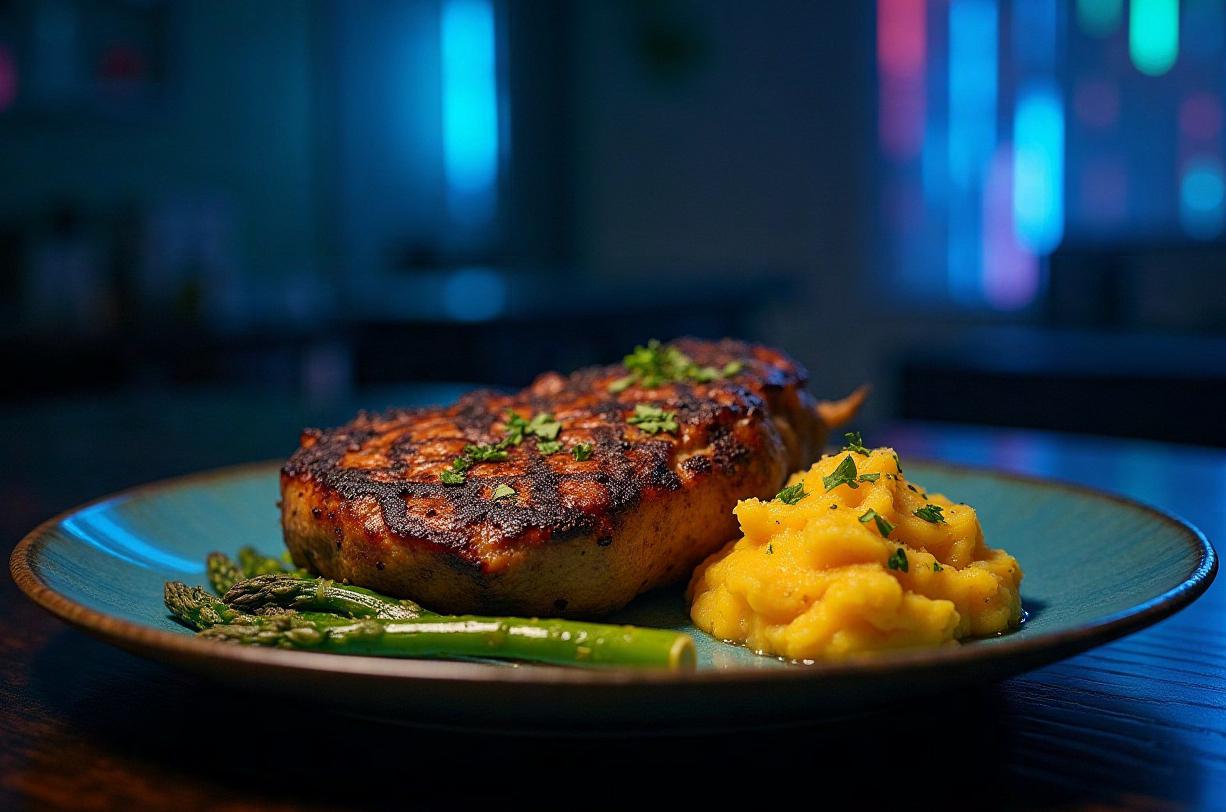
Not long ago, ordering a “meatless burger” meant getting a soggy patty made of lentils or mashed vegetables. Today, things have changed dramatically. Thanks to advances in food technology and changing consumer values, plantbased meat alternatives are becoming mainstream. From fast-food chains to high-end
restaurants, “meat without meat” is being embraced across the globe—and India is no exception.
This shift isn’t just about food. It’s tied to bigger questions about health, sustainability, animal welfare, and how we feed a growing global population. As more people rethink what’s on their

plate, the rise of plant-based meat could mark a majorturningpointinthefutureoffood.
WHAT ARE PLANT-BASED MEATS?
Plant-based meats are food products designed to look, taste, and cook like animal meat—but made entirely from plants. They often use ingredients like soy,peas,chickpeas,jackfruit,wheat,ormushrooms to create the texture and protein content of real meat.
Unlike traditional vegetarian dishes, these products are designed for people who enjoy the taste of meat but want an alternative that’s better for their health or the planet. Companies like Beyond Meat and Impossible Foods in the West, or Blue Tribe, GoodDot, and Imagine Meats in India, have launched products like plant-based burgers, sausages, kebabs, and nuggets that closely mimic realmeatinflavorandappearance.
WHY ARE PLANT-BASED MEATS BECOMING POPULAR?
Several factors are driving the growing interest in plant-basedmeat:
1. Health Consciousness
Many people are turning away from red meat and
processed meats due to health concerns such as heart disease, obesity, and cancer. Plant-based meats offer a way to reduce meat intake while still enjoying similar textures and flavors. These alternatives are usually cholesterol-free, lower in saturatedfats,andhighinplantprotein.
2. Environmental Impact
Animal agriculture is a major contributor to climate change, deforestation, and water use. Producing onekilogramofbeef,forexample,requiresfarmore land and water than producing the same amount of plant protein. By switching to plant-based meat, consumers can significantly reduce their carbon footprintandhelpprotecttheplanet.
3. Ethical Reasons
For many, especially younger generations, concern about animal welfare is a major reason to reduce meat consumption. Plant-based meat offers a cruelty-freeoptionthatstillsatisfiesmeatcravings.
4. Innovation and Taste
Today’s plant-based meats taste much better than the bland veggie patties of the past. Thanks to food science, companies can now replicate the flavor, juiciness, and even the “sizzle” of meat. As taste improves, more meat-eaters are willing to give theseproductsatry.
THE INDIAN ANGLE: A MARKET WITH UNIQUE POTENTIAL
India, with its large vegetarian population, deep culinary traditions, and growing middle class, presentsauniquemarketforplant-basedmeat.
While most Indians don’t eat beef or pork due to religious reasons, chicken, mutton, and fish are widely consumed, especially in urban areas. At the sametime,thereisalong-standingcultureofplantbased eating, making the country a fertile ground foralternativeproteins.
Indian startups like Blue Tribe, co-founded by actor Genelia Deshmukh, are offering products like chicken nuggets and keema made from peas and soy. GoodDot, based in Udaipur, produces readyto-eat plant-based meat dishes that are sold in both local markets and Indian Railways. Imagine Meats, backed by actors Riteish and Genelia Deshmukh, aims to make plant-based meat more appealing to the Indian palate by offering biryanifriendlykeemaandtandoori-stylekebabs.
India’s rich use of spices, sauces, and marinades also makes it easier to mask any differences in taste or texture between plant-based and real meat, helping alternatives blend more seamlessly into everydaymeals.
CHALLENGES FACING THE INDUSTRY
Despite its growth, the plant-based meat industry still faces several hurdles, especially in markets like India.
Plant-based meats are often more expensive than traditional meat or vegetarian protein sources like paneer, lentils, or eggs. For the average Indian consumer, affordability remains a key issue. Companies are working to lower prices through localsourcingandscalingupproduction.
Outside major metros like Mumbai, Delhi, and Bengaluru, plant-based meat is still hard to find. Many consumers aren’t aware of the products, or theyassumeit'sjustforvegans.Moreeducationand visibilityareneededtobroadentheappeal.
In India, food is deeply tied to religion and tradition. Some vegetarians may avoid plant-based meat simply because it resembles meat too closely, while some meat-eaters may not see a reason to switch.
Changinghabitstakestimeandtrust. Togrowsustainably,theindustrymustfocusonusing locally grown ingredients like millets, jackfruit, lentils, and peas, rather than depending on imported soy or expensive additives. Indian food regulations around labelling, safety, and nutritional claims are also still evolving for plant-based products.
THE FUTURE OF MEAT—WITHOUT ANIMALS?
Experts believe the plant-based meat market is just getting started. According to a 2023 report by the Good Food Institute India, the Indian plant-based meat market could grow tenfold over the next five years if supported by investment, consumer education,andpolicychanges.
Globally, even major meat companies like Tyson Foods and Nestlé are investing in plant-based alternatives. In India, restaurant chains, cloud kitchens, and home chefs are starting to include these products on their menus. With growing urban populations, rising health concerns, and increasing climate awareness, plant-based meat could becomearegularpartofthemodernIndiandiet. There is also room for hybrid models—mixing plant and animal proteins—or cultivated meat, which is lab-grown from animal cells but without slaughter. Though still in early stages in India, these technologies are being explored as long-term solutions.
SMALL SWAPS, BIG IMPACT
The rise of plant-based meat is not about turning everyone into a vegan. It’s about offering better choices for health, for the planet, and animals. Even replacing meat once or twice a week with plantbased alternatives can make a meaningful difference.
In a country like India, where food is not just nourishment but culture, identity, and tradition, plant-based meat must earn its place carefully. But with smart innovation, strong storytelling, and local flavors, it has the potential to help Indians eat more sustainably,withoutgivingupthefoodstheylove. The future of meat may not be meat at all. And that future might just taste a lot better than we ever expected.

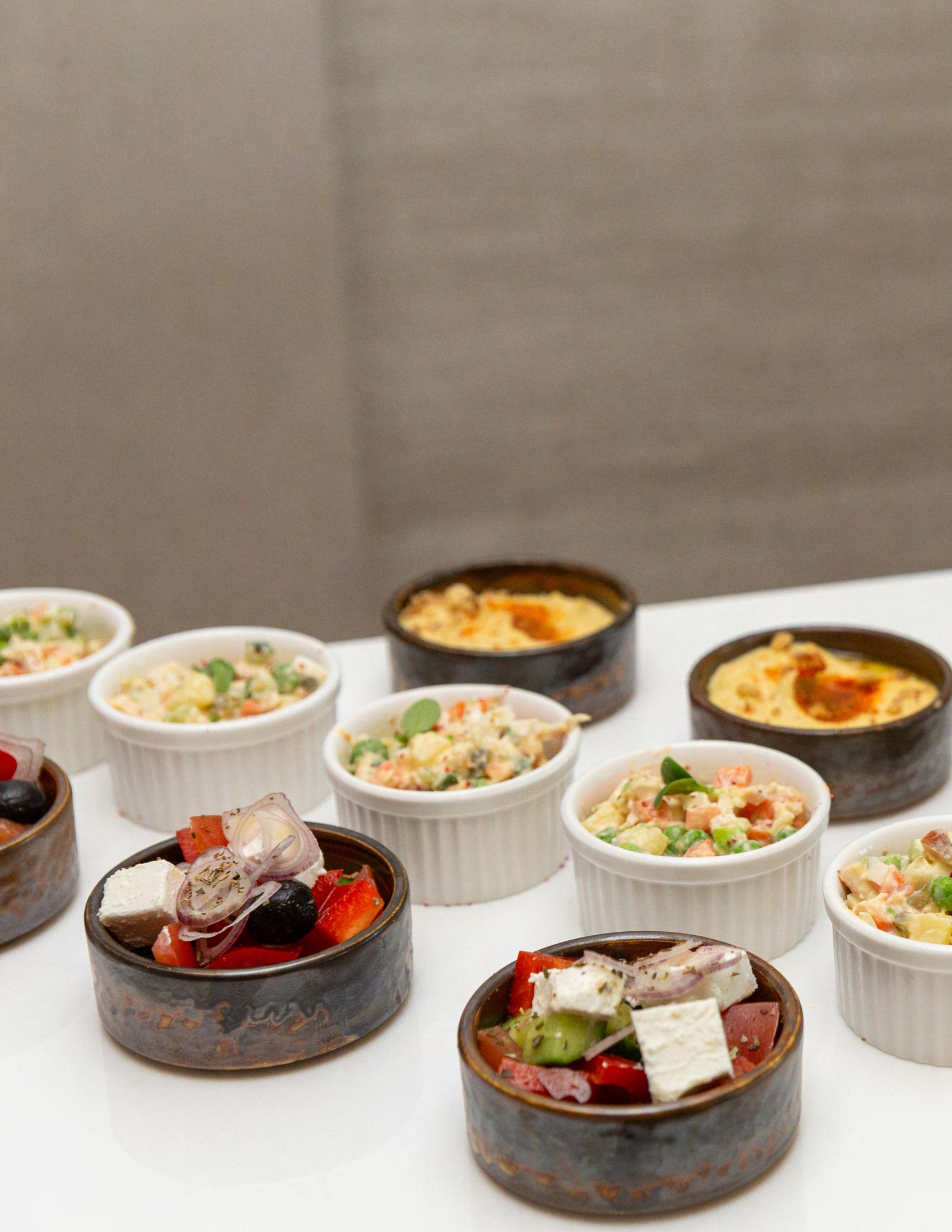
SMALL PLATES BIG PRICES
The Rise of Tapas-Style Dining in Goa
By Gauri Ghadge
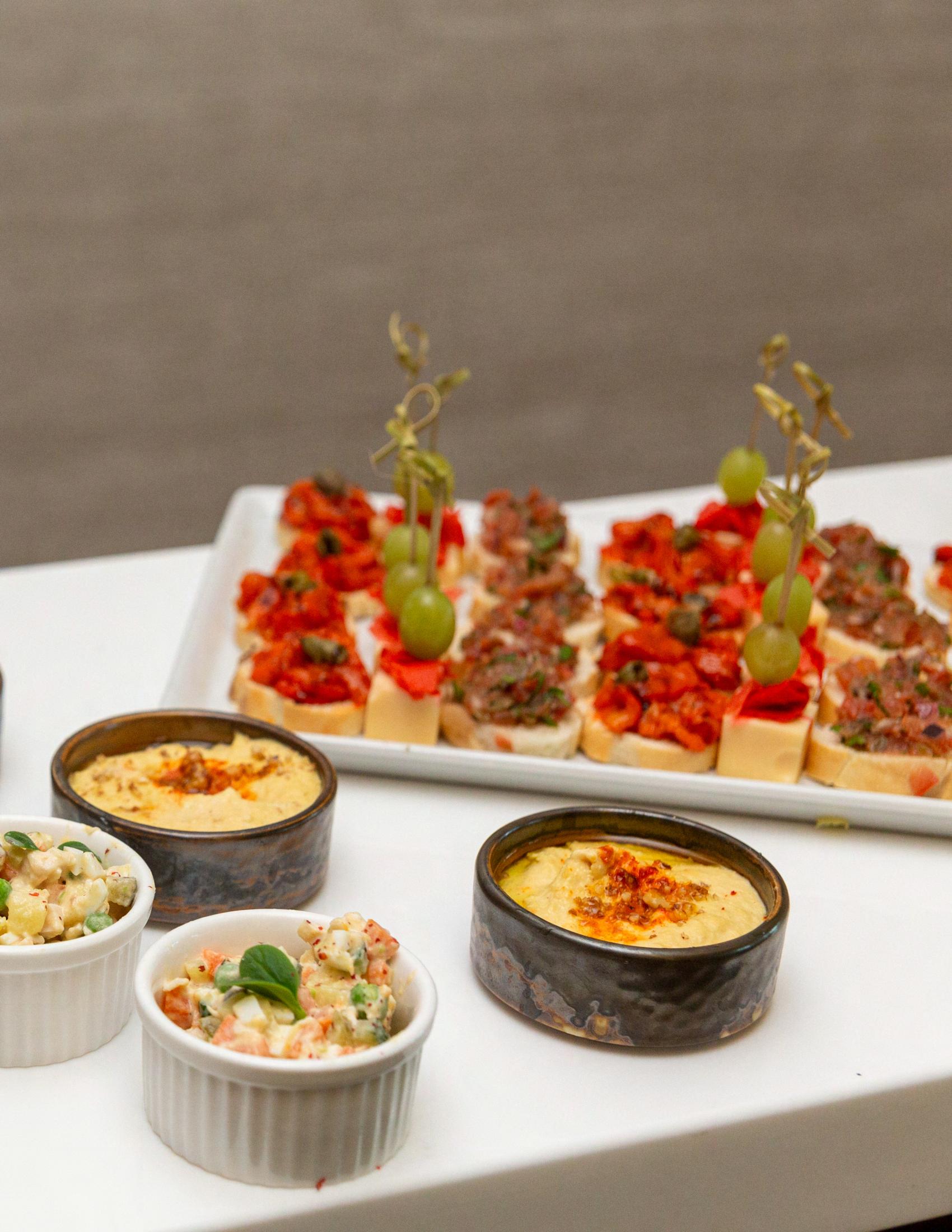
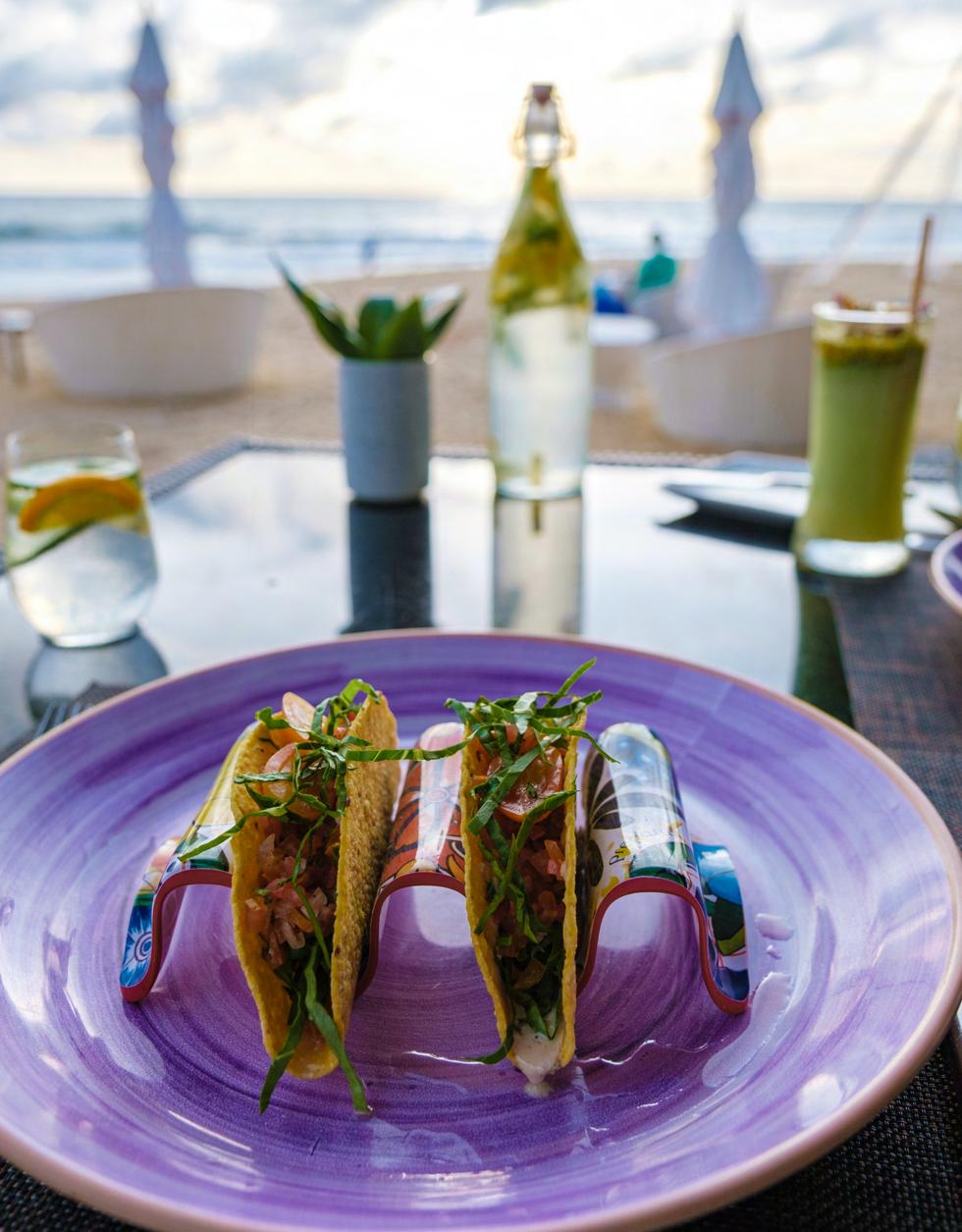
INTRODUCTION: A REVOLUTION ON THE PLATE
It begins with a whisper of beetroot espuma, a sliver of cured kingfish, and three impeccably plated microgreens dustedwithedibleash.Theprice?�750. Welcome to the world of tapas-style dining, where less is more, aesthetics rule, and your plate might resemble a canvas more than a meal. Once synonymous with the sun-soaked bars of Spain, tapas culture has now made its luxurious pivot into Goa’s vibrant food scene, not as casual bites over wine, but as a statement of refinement, ambition,andprice-taggedartistry. What was once a land of thali houses,
seafood shacks, and hearty susegad meals is now embracing a culinary transformation that is as controversial as it is compelling. This cover story unpacks the phenomenon in full — its origins, economics, philosophy, presentation, criticism, and where it mayleadnext.
Tapas has evolved from mere sustenance to become a cultural artefact. It draws from art, performance, and nostalgia, converging at the intersection of hospitality and storytelling. In Goa, it’s rewriting not only menus but mindsets. Let’sexplorethistransformationinallits dimensions.
FROM SPAIN TO SALIGAO: HOW TAPAS TOOK ROOT IN GOA
Tapas, the quintessential Spanish culinary tradition, has a rich and multifaceted history. The term "tapas" derives from the Spanish verb tapar, meaning "to cover." One popular legend suggests that King Alfonso XIII, while visiting a tavern in Cádiz, was served a glass of sherry covered with a slice of ham to protect it from dust and flies. The king appreciated this gesture and requested another drink "with the cover," leading to the term "tapas" becoming synonymous with small bites servedalongsidebeverages.
Traditionally, tapas were simple accompaniments to drinks, such as olives, cheese, or cured meats. Over time, they evolved into a diverse array of dishes, ranging from cold items like ensaladilla rusa to hot preparations like patatas bravas and gambas al ajillo. The essence of tapas lies in their communal nature, encouraging sharing andconversationamongdiners.
In recent years, Goa has witnessed a culinary renaissance, with tapas-style dining gaining prominence. This trend is not merely a replication of Spanish customs but a creative fusion that reflects Goa's unique cultural tapestry. Goan chefs and restaurateurs have embraced the tapas concept, infusing it with local flavours and ingredients. For instance, traditional Goan dishes like recheado-stuffed mushrooms and feni-infused ceviche are presented in bite-sized portions, aligning with the tapas philosophy of variety and shared experiences.
The Portuguese colonisation of Goa, which lasted over 450 years, left an indelible mark on its cuisine. Dishes suchasvindaloo,sorpotel,andfeijoada showcase the amalgamation of Portuguese culinary techniques with local ingredients and spices. This historical fusion provides a fertile groundforthetapasconcepttoflourish in Goa, allowing for innovative interpretations that honour both SpanishandGoantraditions
Moreover, the modern Goan dining scene, particularly in areas like
Assagao and Fontainhas, has become a hub for experimental gastronomy. Restaurants and bars are curating menus that offer a medley of small plates, each telling a story of cultural convergence. The tapas trend in Goa is not just a nod to Spanish customs but a testament to the region's evolving culinary identity, where global influences harmoniously blend with localheritage.
CULINARY THEATRE: WHERE EVERY PLATE PLAYS A ROLE
Diningtodayisnotjustamatteroftaste — it's a spectacle. And tapas, with its emphasis on minimalism and presentation, fits perfectly into this performance. At Goa’s new-age dining spaces, plates are served like dramatic monologues: unveiled beneath glass domes, garnished with edible flowers, and explained with the reverence of a gallerytour.
Lighting, music, scent, temperature — all are orchestrated to amplify the plate. The table becomes a stage. The diner, an audience member. Tapas fits the algorithm of attention: small, stunning, and instantly shareable. It’s food as performance, plated for applause and served with a side of Instagram.
This performative element is both a boon and a challenge. While it draws patrons and social media buzz, it also raises the stakes for consistency and authenticity. A tapas meal is a series of acts, and like theatre, it must deliver an emotional arc. One dish must surprise, another comfort, and yet another sparks curiosity. The choreography of this experience is what defines its brilliance.
Tapas also changes how a restaurant is perceived. Guests aren’t just patrons; theybecomecollaboratorsinacurated experience. The format invites feedback, pauses, moments of reflection, and even debate. Unlike a linear three-course meal, tapas is fragmented — each plate holding its own story, yet weaving a larger narrative. And in Goa, where storytelling is integral to culture, this formatfindsfertileground.

THE GOA EFFECT: LOCAL FLAVOURS MEET GLOBAL PALATES
In a place where cuisine is already a crossroads of cultures, the arrival of tapas-style dining in Goa didn’t disrupt the narrative — it elevated it. What began as a European idea has taken on distinctly Goan hues, resulting in a new dining dialect where coconut meets aioli, and cafreal rubs shoulders with chorizo oil. This is not just fusion for the sake of flair — it’s the natural evolution of a state whose palate has always dancedbetweencontinents.
Goa's history is a tapestry stitched with trade, colonisation, and migration. Nowhere is this more apparent than in
its kitchens. The 451-year-long Portuguese colonisation brought with it more than churches and architecture — it changed the way Goans cooked and ate. New ingredients like cashew nuts, vinegar, potatoes, tomatoes, and chilli peppers were integrated into local diets. The result was a symbiotic marriage of Iberian and Konkani cooking traditions. Dishes such as vindaloo (from the Portuguese vinha d'alhos) and sorpotel (from sarapatel) are just two of the many examples that represent this hybrid legacy. This history of culinary cross-pollination laid the perfect foundation for today’s global food trends to take root. Tapas may be Spanish in origin, but in Goa, it found
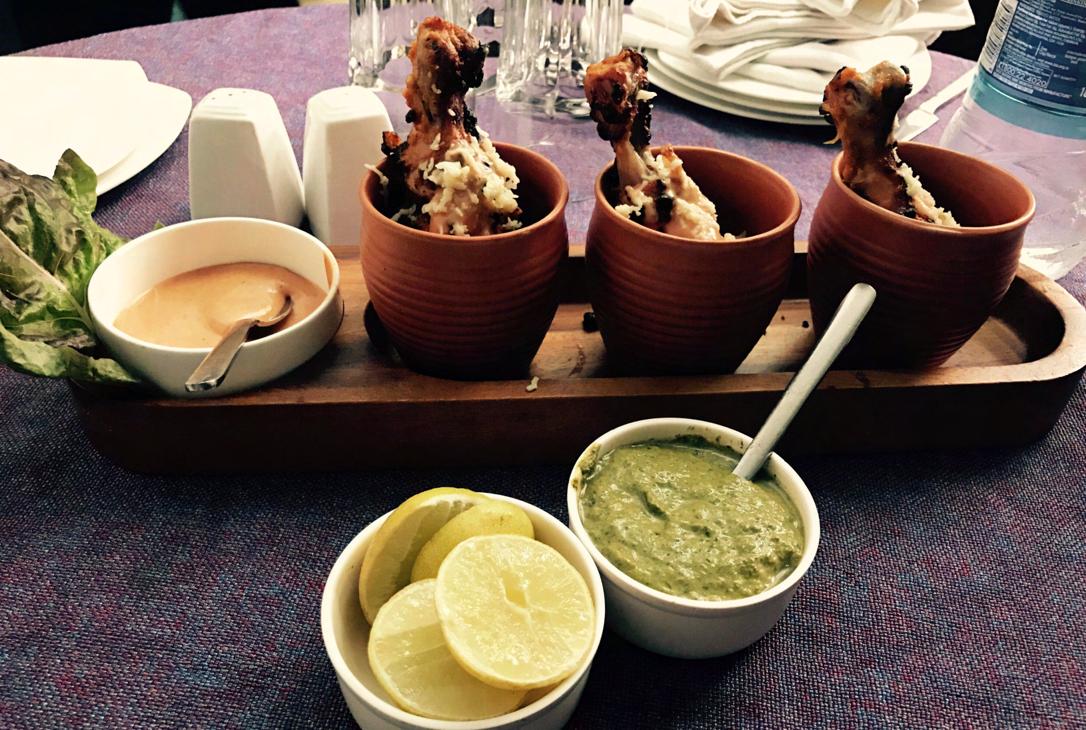
kindred soil — a land already accustomed to mixing the foreign with thefamiliar.
Walk into any of Goa’s new-age restaurants in Assagao, Anjuna, or Fontainhas, and you’ll notice a pattern. Small plates, big flavours, and unmistakableGoansoul.Afeni-smoked oyster might sit beside a beetroot carpaccio drizzled with kokum glaze. Recheado masala is reinvented as a stuffing for arancini. Cafreal may appear, not as grilled chicken, but as a green emulsion accompanying a seafoodtartlet.
These are not imitations of Spanish tapas. Instead, they are reinterpretations — driven by Goa’s ingredients, traditions, and storytelling.The chefs here are not merely borrowing techniques; they’re redefining them with a distinctly Goan compass. What stands out in this tapas evolution is not just the presentation — it's the intention. The goal is to surprise, to challenge expectations, and to create a multi-sensory experience that stillfeelsdeeplyrootedinplace.
Central to this movement is the celebration of local produce. Goa’s bounty—fromkokumandtoddyvinegar to wild mushrooms, sea urchins, and tribal greens — is being reimagined
through global lenses. Tapas dishes increasingly feature hyper-local ingredients not just for novelty but as a declaration of identity. Feni, once relegated to the back shelves of beach bars, now stars in gastrique sauces and shellfish reductions. Harmal chillies and Bicholim bananas find their way into pickles,foams,anddusts.Toddyvinegar is no longer just for pork but is used in brines, vinaigrettes, and reductions, giving modern dishes an unmistakable punch of Goa. Even dessert menus are part of the revolution — think jaggery crème brûlée, kokum sorbet, or bebinca ice cream served as part of a fivecoursetastingmenu.
This isn’t a one-sided affair. While Goa is absorbing global influences, it’s also exporting its own culinary philosophies. More chefs visiting from abroad are now experimenting with Goan flavours, incorporating them into their pop-ups and residencies across India and beyond. The global palate, increasingly curious and diverse, is more open than ever to what Goa brings to the table, especially when it’s packaged in a format as accessible and engaging as tapas. It’s a two-way street — Goan chefs are learning from world cuisines, and international diners are discovering Goa beyond vindaloo and
prawncurry.
Goa’s embrace of tapas-style dining is not just an aesthetic shift — it’s an assertion. It says that this small state, known for susegad and spice, can also play confidently in the arena of haute cuisine.Itshowsthatglobaltrends need not dilute local heritage — they can, when handled thoughtfully, amplify it. The tapas movement in Goa is not about foreign mimicry. It is about reclaiming global formats to tell local stories — of tradition, reinvention, community, and creativity.Inthesesmallplateslies something big: the assertion that Goa’s culinary future can be as layeredandglobalasitspast,and justasflavorful.
THE PSYCHOLOGY OF SMALL BITES
In Goa’s evolving dining landscape, the shift from hearty thalis to meticulously crafted small plates is more than a culinary trend—it's a reflection of deeper psychological dynamics that influence how we perceive, enjoy, and rememberourmeals.
MINDFUL CONSUMPTION AND SATIETY
Recent studies have highlighted the benefits of consuming smaller bites. A study published in Nutrients found that participants who took smaller bites and chewed more thoroughly experienced longer meal durations, allowing their bodies more time to register fullness, thereby reducing the likelihood of overeating. This aligns with the principles of mindful eating, where slowing down and savouring each bite enhances the dining experience and promotesbetterdigestion.
SENSORY-SPECIFIC SATIETY
The concept of sensory-specific satiety explains how our appetite for a particular flavour diminishes as we consume it, but introducing a new flavourcanrenewourinterestineating. Tapas-style dining, with its variety of flavours and textures, leverages this phenomenon, keeping the dining

experience exciting and satisfying withoutleadingtooverconsumption.
VISUAL PERCEPTION AND PLATE DESIGN
The presentation of food significantly affects our perception of portion size and satisfaction. The Delboeuf illusion demonstrates that the same amount of food appears more substantial on a smaller plate than on a larger one. By serving small bites on appropriately sized dishes, chefs can enhance the visualappealofthemeal,makingitfeel morefulfilling.
SHARED EXPERIENCES AND SOCIAL DYNAMICS
Diningisinherentlyasocialactivity,and sharing small plates fosters a sense of community and connection. Research indicates that shared consumption experiences can amplify enjoyment and create stronger social bonds among diners. In Goa's vibrant culinary scene, tapas-style dining encourages communal eating, allowing guests to explore a variety of dishes together, enhancing both the social and gastronomicexperience.
COGNITIVE BIASES AND MEMORY
Our memories of meals are often influenced by the most intense moments and the final bite, a concept knownasthepeak–endrule.Bycurating a sequence of small, flavorful dishes, chefs can craft a dining experience that leaves a lasting positive impression, encouraging repeat visits andword-of-mouthrecommendations.
THE BUSINESS BEHIND THE BITES
Beneath the beauty lies a clever business model. Tapas dining, though demanding in creativity, offers restaurateurs flexibility and higher profitability. Smaller plates allow for better control of food costs, lower waste, and the ability to respond swiftly toseasonalingredientchanges. Chefs get to experiment more, testing new combinations without overhauling their entire menu. For diners, this variety drives return visits. For restaurateurs, it spells high table turnover, better
inventory rotation, and more Instagram-worthy content per square inchoffood.
Goa’s hospitality entrepreneurs are also discovering that tapas fits seamlessly with lifestyle tourism. Travellers seek “experiences,” and a meal comprising seven eclectic plates — each one styled and explained — offers more storytelling power than a standard à la carte menu. In a state where tourism fuels business, tapas is provingtobemorethanaculinarytrend —it’sabrandingtool.
THE CRITICISM AND CULTURAL DEBATE
Yet, not everyone is cheering the tapas wave. Critics argue that the format leans heavily toward elitism. With each dish priced between �400 to �1200, an evening out can quickly escalate beyond reach for the average diner. The irony of ‘small food, big price’ is not lost on a state where many still value quantityasamarkerofhospitality. There are also concerns around authenticity. When global techniques overshadow local narratives, there’s a risk of losing culinary identity under layersofedibleglitter.Isaporksorpotel foam still sorpotel? Or a coconut xacuti broth deconstructed into an espuma — stillxacuti?
For some Goans, tapas-style reinterpretation is a celebration of identity. For others, it feels like a polished export version of tradition — a culinary makeover tailored for Instagramandhigh-incometourists. Still, these conversations are vital. They indicate that food is not just nourishment or novelty — it’s memory, culture, and emotion. And if tapas provokes dialogue, perhaps it is doing exactlywhatgreatfoodshould.
SUSTAINABILITY AND THE SMALL PLATE
Amid rising awareness around sustainability, tapas-style dining is carving out an unexpected green identity. By emphasising smaller portions, it reduces food waste significantly. Kitchens that serve tapas
often follow a philosophy of precision—cooking with intent rather thanexcess.
The tapas format also allows for greater use of local, seasonal ingredients. In Goa, this means spotlighting microgreens from backyard farms, coastal shellfish from village markets, and artisanal salts and oils that might otherwise be overlooked inavolume-drivenkitchen.
What’s more, the rise of plant-forward tapasmenusishelpingalignthisstyleof dining with ethical, environmental, and health-conscious practices. From beetroot tartare to moringa crisps and banana blossom croquettes, chefs are pushing the boundaries of sustainability, without sacrificing flavourorflair.
Of course, not all tapas venues are created equal. Some indulge in excess in the name of art. But the best ones — the ones shaping Goa’s new culinary story — are deeply aware of their impact, both gastronomic and ecological.
CONCLUSION: A NEW CHAPTER ON THE GOAN TABLE
Tapas-style dining in Goa isn’t just a passing trend. It’s a paradigm shift in how we eat, how we serve, and how we think about food. It’s reshaping the very definition of dining from a linear, platebound experience to a fluid, multifacetedjourney.
From the flamboyant flair of Assagao’s pop-up bistros to the mindful elegance of South Goa’s garden cafés, the small plate has carved a big place in the hearts — and palates — of both locals and travellers. It challenges the diner to pay attention, to savour slowly, and to see food not just as sustenance but as conversation,memory,andart.
As with any transformation, there are growing pains. Questions of accessibility, authenticity, and excess remain. But the dialogue is alive. And in Goa — a land of layered histories and bold reinvention — that conversation is exactlywhatmakestapasfeelathome. Yes, the plates may be small. But their impact? That’s big.








INCREDIBLE KITCHEN

CHILLED AVOCADO & SPINACH SOUP WITH LEMON ZEST OIL
By Aditi Malhotra
If there’s a dish that perfectly captures the essence of summer—light, refreshing, and full of goodness—it’s a chilled soup. This vibrant green version combines buttery avocado, tender spinach, cooling yogurt, and a touch of spice for depth. What makes it truly special is the lemon zest oil drizzled on top, offering a citrusy punchthatliftsthecreaminess.It’selegantenoughforadinnerpartyandeasyenoughforalazysololunch.
INGREDIENTS
For the soup:
1 ripe avocado
1 cup fresh spinach leaves (blanched and cooled)
1/2� cup thick yogurt or Greek yogurt
1 small cucumber, peeled and chopped
1 small clove garlic
1 green chilli (optional, for mild heat)
Juice of 1 lemon
1 tbsp olive oil
Salt and freshly cracked pepper to taste
Cold water or chilled vegetable stock, to adjust consistency
For the lemon zest oil:
2 tbsp extra virgin olive oil
Zest of 1 lemon
A pinch of chilli flakes (optional)
Method
Prepare the lemon zest oil:
F Warm the olive oil in a small pan on low heat (do not boil).
F Add the lemon zest and chilli flakes, stir, and turn off the heat. Let it infuse for 10 minutes. Strain if desired and cool completely.
Make the soup:
F In a blender, combine avocado, spinach, cucumber, garlic, green chilli (if using), yogurt, lemon juice, salt, and pepper.
F Blend until smooth. Add cold water or chilled stock to reach your desired texture—it should be drinkable but creamy.
F Taste and adjust seasoning. Chill for at least 30 minutes before serving for the flavours to come together.
To Serve:
F Pour into chilled bowls or glasses. Drizzle the lemon zest oil on top, and garnish with microgreens, edible flowers, or toasted sunflower seeds for crunch.
INCREDIBLE KITCHEN
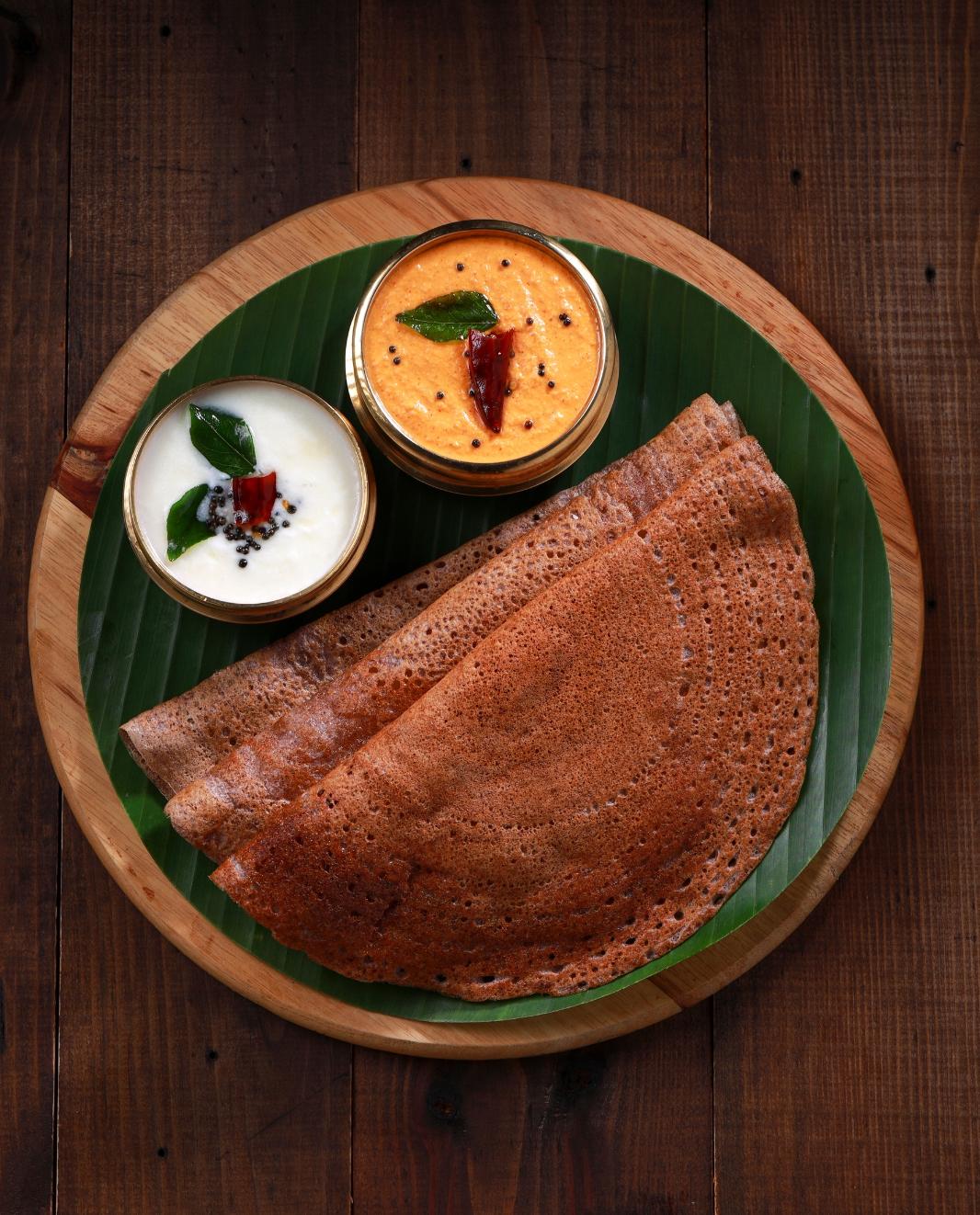
RAGI DOSAS WITH HERBED YOGURT & PICKLED VEGETABLES
By Aditi Malhotra
Dosas may be a staple across India, but this earthy, modern variation made with ragi (finger millet) brings a fresh and wholesome twist to the table—perfect for summer. Naturally gluten-free and rich in calcium and fiber, ragi makes for a light, crisp dosa that’s both nourishing and satisfying. Paired with cool herbed yogurt and a side of quick pickled vegetables, this dish is ideal for breakfast, lunch, or even a breezy weeknight dinner.
INGREDIENTS
For the Ragi Dosas
1 cup ragi flour
1/4� cup rice flour (for crispiness)
1/2� cup curd (for slight tang)
1/2� tsp cumin seeds
Salt to taste
1–1.25 cups water (as needed for batter consistency)
Ghee or oil for cooking
For the Herbed Yogurt
1 cup thick yogurt (hung curd or Greek yogurt)
1 tbsp finely chopped dill
1 tbsp finely chopped mint
1 tsp lemon zest
Salt & cracked pepper to taste
Method
Make the pickles
For the Ragi Dosas
1 cup ragi flour
1/4� cup rice flour (for crispiness)
1/2� cup curd (for slight tang)
1/2� tsp cumin seeds
Salt to taste
1–1.25 cups water (as needed for batter consistency)
Ghee or oil for cooking
F In a bowl, combine vinegar, sugar, salt, and mustard seeds. Stir until sugar dissolves.
F Add the sliced vegetables and let sit for at least 30 minutes. Refrigerate for longer shelf life and enhanced flavor.
Prepare the herbed yogurt
F Whisk yogurt until smooth. Add herbs, lemon zest, salt, and pepper. Chill until ready to serve.
F Make the ragi dosas
F In a bowl, combine vinegar, sugar, salt, and mustard seeds. Stir until sugar dissolves.
F Add the sliced vegetables and let sit for at least 30 minutes. Refrigerate for longer shelf life and enhanced flavor.
To Serve
Plate the dosas warm with a generous scoop of the chilled herbed yogurt and a spoonful of the tangy pickled vegetables. Garnish with microgreens or toasted sesame seeds for texture.
THE FORBIDDEN MENU DISHES BANNED, BOYCOTTED, OR CANCELLED?
By Gauri Ghadge
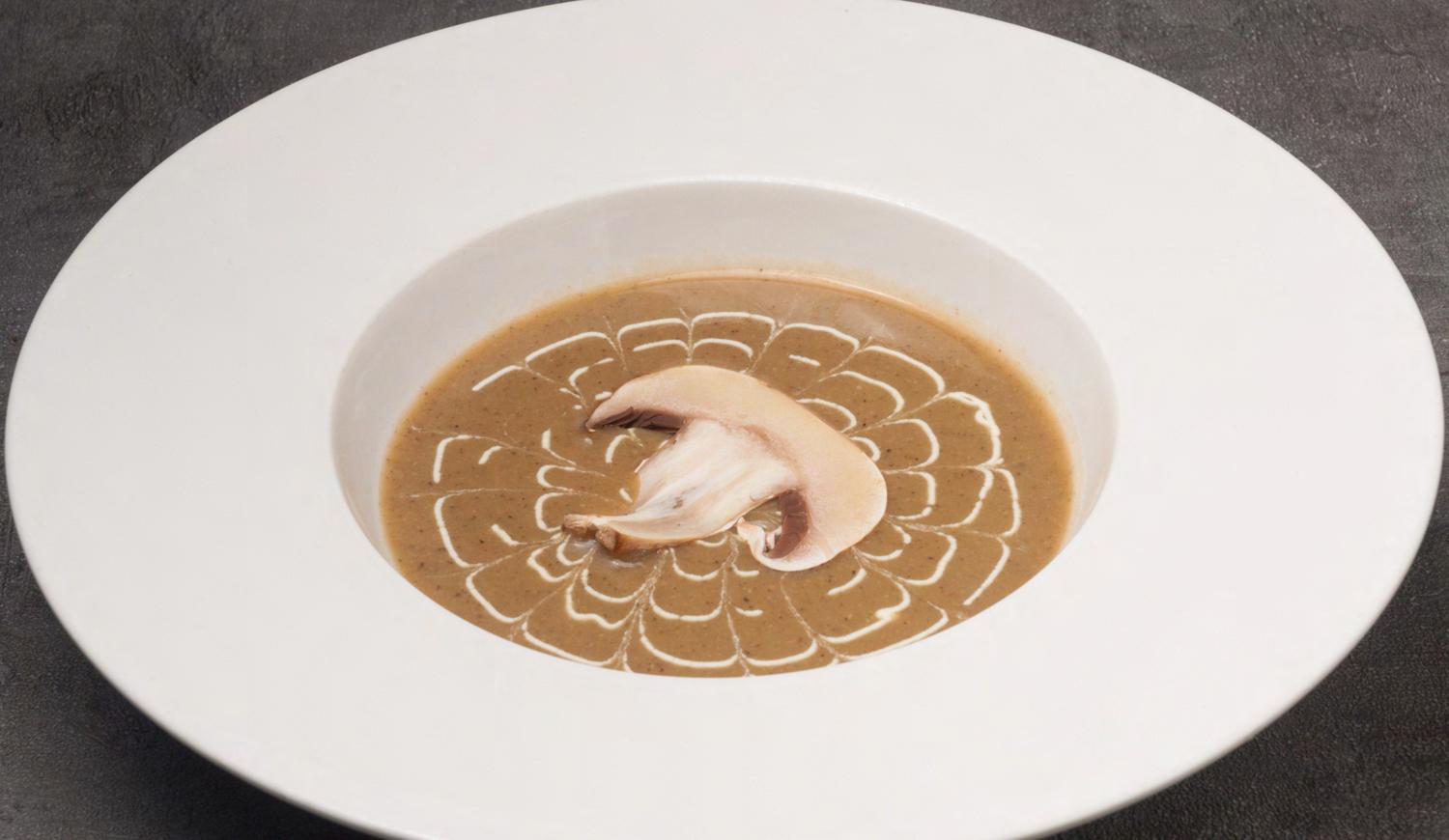
In the glittering world of gourmet dining, where everybiteisastatementandeverydishaspectacle, certain delicacies stand apart—not for their taste, but for the ethical firestorms they ignite. These are notyourusualentrées.Theyareiconsofindulgence, steeped in centuries of tradition, prestige, and culinary craftsmanship. Yet behind their golden
platingandexaltedstatusliesadarkertruth—oneof animal cruelty, ecological destruction, cultural reckoning,andmoraloutrage.
Welcome to The Forbidden Menu—a provocative exploration of foods that have been banned, boycotted, or culturally canceled in an age when what we eat is under more scrutiny than ever
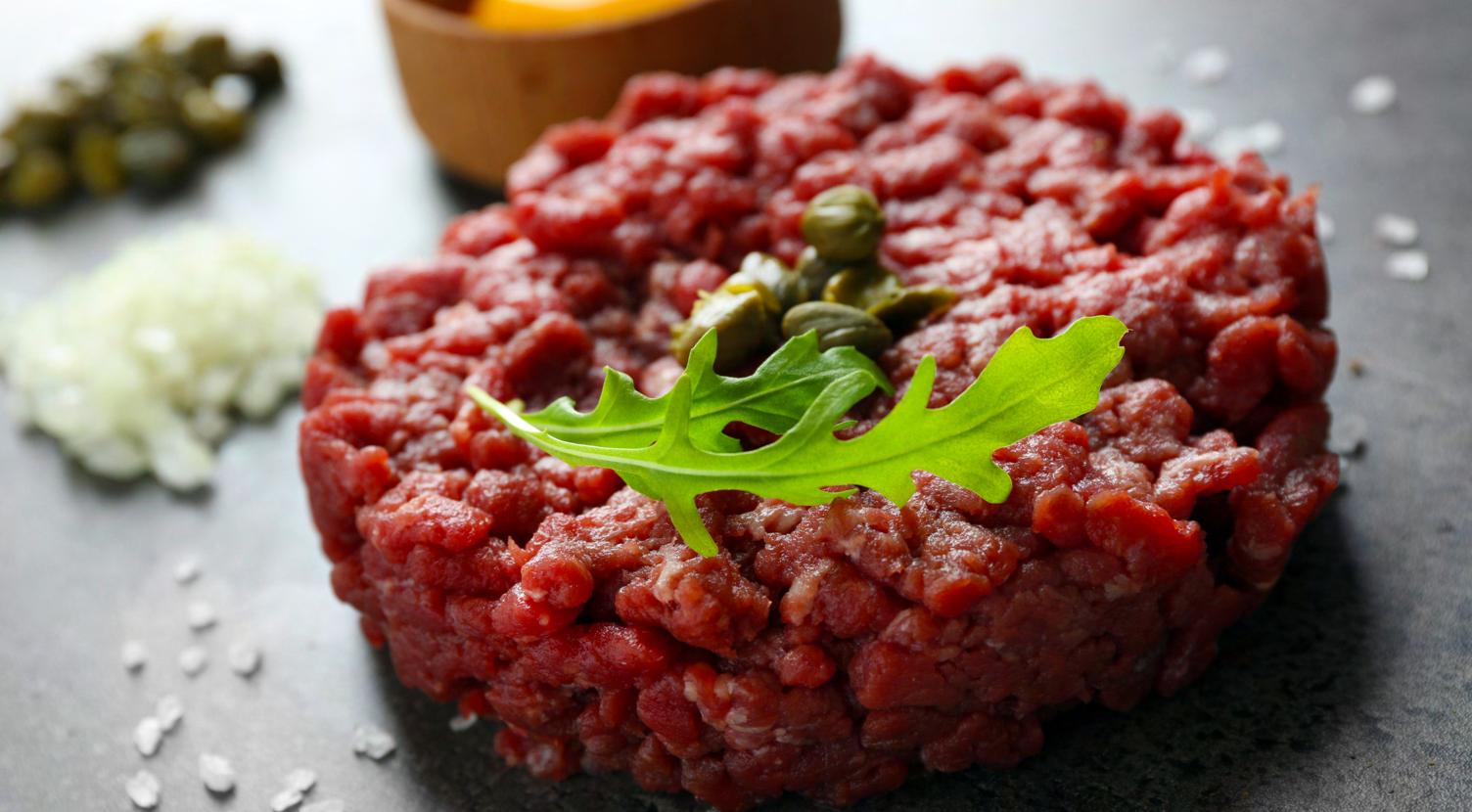
before.
FOIE GRAS: FROM HAUTE CUISINE TO HUMANITARIAN HORROR
Foie gras—literally “fatty liver” in French—was once the pride of haute cuisine. Achieved by forcefeeding ducks or geese until their livers swell up to ten times their normal size, the resulting dish is prizedforitsrich,butterytexture.
Butthisindulgencecomesatadevastatingcost. The process, known as gavage, involves inserting a metal tube down the throats of birds multiple times a day. Footage from undercover investigations has revealed appalling conditions: birds collapsing under the weight of their own livers, open sores, damaged organs, and cramped cages. These imageshavesparkedinternationalbacklash.
India was the first country in the world to ban the import of foie gras in 2014, despite never producing it domestically. The UK, Argentina, and parts of the U.S. followed suit. Major retailers such as Whole Foods removed it from their shelves, and cities like New York upheld bans even in the face of legal battles.
Still, in France, foie gras remains a fiercely protected tradition—recognized as part of the country's cultural heritage. But even there, change is brewing, with chefs experimenting with “faux gras” made from lentils, mushrooms, and plant fats that mimic the original's richness without the cruelty.
SHARK FIN SOUP: DECADENCE OR DESTRUCTION?
In East Asia, shark fin soup has long symbolized status and prosperity, especially at weddings and banquets. Its gelatinous texture, more than its taste, iswhatdinerssought.
But the practice behind the dish—finning—is nothing short of brutal. Sharks are caught, their fins sliced off, and their bodies tossed back into the ocean, alive and unable to swim. They slowly sink and suffocate.
The ecological impact is staggering. Sharks are apex predators, vital to ocean ecosystems. A 2021 Nature study revealed a 70% drop in global shark and ray populations over 50 years, largely due to finning.
Public outcry has prompted governments to act. Canada banned shark fin sales in 2019. The U.S. passed the Shark Fin Sales Elimination Act in 2022. Even China, once the largest market, has seen demand drop 70% thanks to government discouragement and awareness campaigns by figureslikeJackieChanandYaoMing.
Yet, black markets in parts of Southeast Asia and Africa keep the trade alive, underscoring the need forglobalenforcement.
ORTOLAN BUNTING: CONSUMED IN SILENCE
Few dishes evoke as much shame as the ortolan bunting. This tiny French songbird is trapped,
blinded, force-fed, drowned in Armagnac, then roasted and eaten whole. Diners traditionally cover their heads with a napkin during the act—not for aroma,butto“hidetheshamefromGod.”
The EU banned ortolan hunting in 1999, but enforcement was lax for years. The dish continued to be consumed secretly, often by elites and celebrity chefs. It wasn't until 2018 that France truly cracked down on the illegal trade, raiding poachers andenforcinglawsmorerigorously.
The ortolan has become a tragic symbol of gastronomic extremism—a bird once admired for its song, now remembered for the silence it inspired at dinnertables.
CASU MARZU: CHEESE THAT CROSSES THE LINE
From the remote hills of Sardinia comes Casu Marzu, a cheese so infamous it's often called “the most dangerous cheese in the world.” To make it, locals introduce cheese flies into wheels of pecorino. The maggots digest the fats, turning the cheese into a soft, pungent paste that literally moves.
While revered in Sardinian culture, Casu Marzu is illegal under EU food safety laws due to risks of infection and allergic reaction. Eating live maggots—some of which may survive digestion—posesclearhealthconcerns.
Still, the cheese persists. Sold under-the-table and gifted between families, it represents defiance, identity,andtheboundariesofculinarybravery.
FUGU: JAPAN'S DEADLIEST DELICACY
Fugu, or pufferfish, is a Japanese dish served under the shadow of death. Its organs contain tetrodotoxin, a toxin more potent than cyanide. Just one error in preparation can lead to paralysis, respiratory failure, and death. There's no known antidote.
Only highly trained and certified chefs are allowed to prepare fugu in Japan. Despite precautions, cases of poisoning still occur—usually among home cooksorunlicensedrestaurants.Between2000and 2020, dozens of people were hospitalized or died aftereatingfugu.
Countries like China, the EU, and parts of the U.S. have banned its import or sale. Even in Japan,
certain parts of the fish are banned from consumption.Yet,forsome,thedangerispartofthe appeal. The tingling sensation on the lips is a flirtationwithfate—aculinarydaredevil'sdream.
HORSE MEAT TARTARE: A FADING CONTROVERSY
Once a popular dish across France, Belgium, and Japan, horse meat tartare has nearly vanished from the global culinary map. Served raw and delicately seasoned, it was a delicacy once treated with the samereverenceassteaktartare.
But changing attitudes and regulations have dramatically reduced its availability. In the U.S., the slaughter of horses for food has been effectively banned since 2007. In India, horse meat is illegal underthePreventionofCrueltytoAnimalsAct.Even intheEU,whereitremainslegal,consumertrustwas rockedbythe2013horsemeatscandal—whenhorse DNA was found in mislabeled beef products across severalcountries.
Restaurants began to quietly remove it from menus. In Japan, it still exists as basashi, but it's far less common than before. The dish may not be illegal everywhere,butit'sincreasinglyunwelcome.
A MENU OF REFLECTION, NOT JUST FLAVOUR
These banned or boycotted dishes are not merely culinary oddities—they are reflections of shifting ethics, evolving legislation, and the growing awareness of how food choices impact the planet anditscreatures.
Once considered the pinnacle of culinary sophistication, these foods now serve as cautionary tales. They remind us that prestige cannot come at the cost of pain, that indulgence cannot outweigh integrity. From the back kitchens of Michelinstarred restaurants to home cooks experimenting with sustainable alternatives, a quiet revolution is underway—one that values conscience as much as craft.
We are now entering an age where what's on the menumattersasmuchaswhat'sleftoffit.
Because in a world awakening to the consequences of consumption, some flavours are better left behind—not for lack of taste, but out of respect for somethingfarmorelasting.

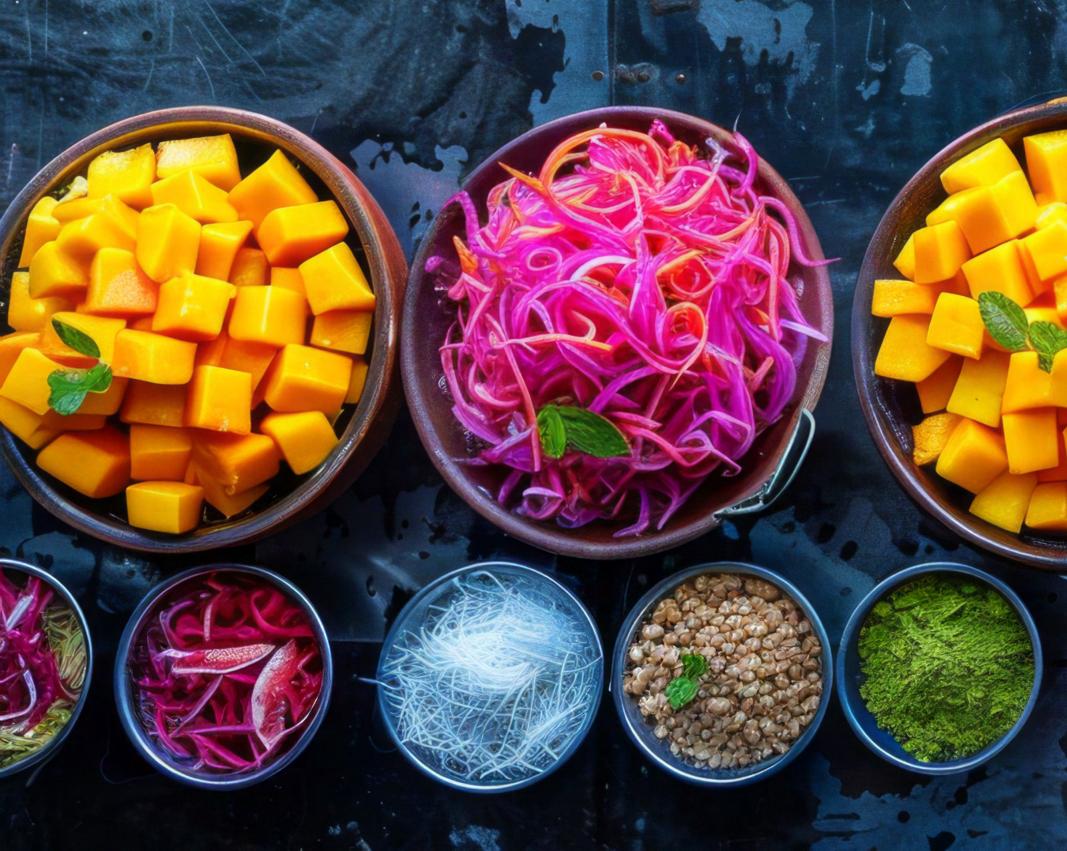
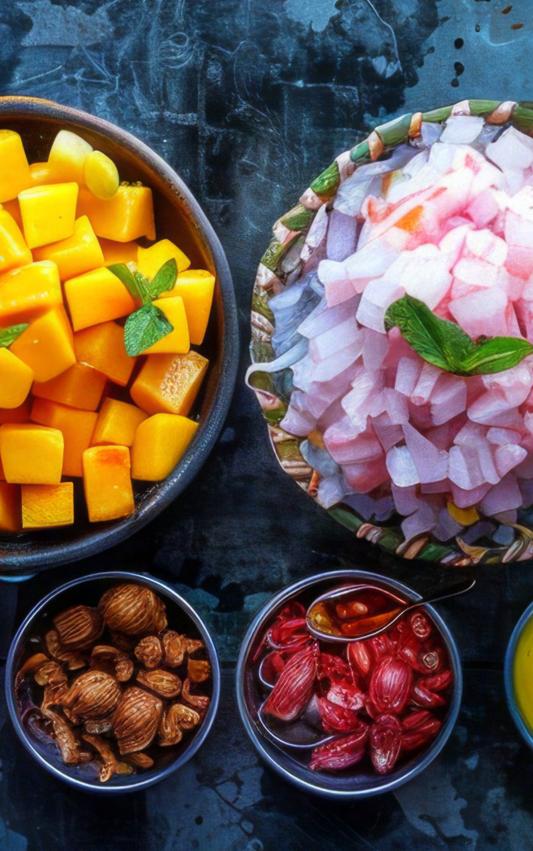
FROM TABLE TO TREND
How Indian Ingredients Are Inspiring Global Menus
ByArmaan Malhotra
WHEN KOKUM MEETS COCKTAILS AND MILLETS GRACE MICHELIN-STARRED PLATES
There was a time when Indian ingredients were viewed through a narrow lens—spices for curry, mangoes for chutney, and lentils for homestyle dals. But today, that perception is being turned on its head. From kokum and moringa to foxtail millet and jackfruit, Indian ingredients are now stepping out of grandma’s kitchen and onto the global stage—refined, repackaged,andcelebrated.
This isn’t just about exotic appeal. It’s about flavour, function,
and identity. Chefs across the world—both Indian and international—are increasingly tapping into the richness of Indian produce, not as novelty, but as sustainable, healthforward, and flavour-intense additions to their culinary vocabulary.
AND THE WORLD IS EATING IT UP—QUITE LITERALLY
A few years ago, millets were seen as old-school grains—meant for diabetics, rural kitchens, or budget meals. Today, they’re showing up as puffed amaranth granola, millet
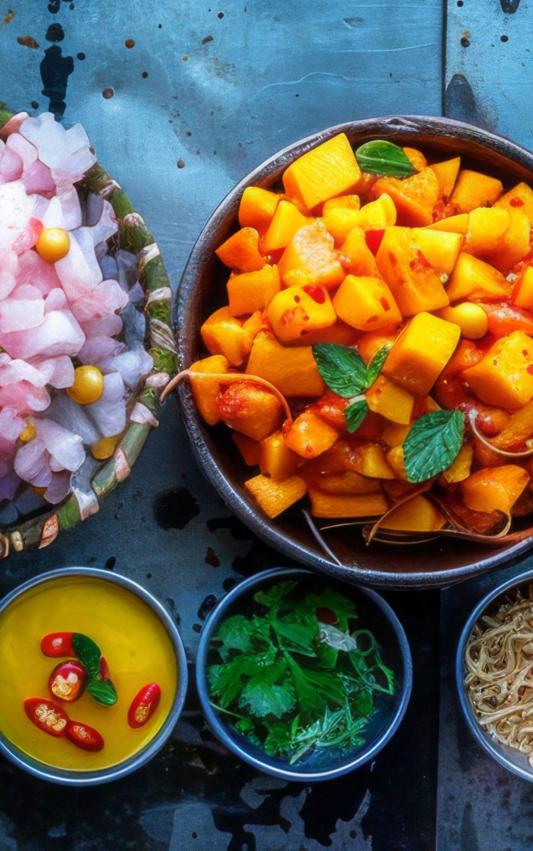

risotto, and jowar tacos on menus from Tokyo to Toronto. The shift isn’t just trend-driven—it’s deeply rooted in nutrition science,sustainability,andstorytelling.
Millets (like foxtail, barnyard, bajra, and ragi) are gluten-free, climate-resilient, and rich in minerals—qualities the world now valuesmorethanever.
Moringa (drumstick leaf) has become a poster child for superfoods, often compared to matcha and spirulina in its antioxidantprofile.
Jackfruit is celebrated as a plantbased meat alternative, appearing in tacos, burgers, and even dumplings across vegan kitchens in theWest.
Suddenly, what was once considered "humble" is now heroic—andproudlyso.
In India, restaurants in places like Goa are already exploring these ingredients with nuanced sophistication.Think:
Ÿ Kokum And Smoked Salt Margaritas
Ÿ Black rice arancini with spiced coconutchutney
Ÿ Jaggeryandsesamepralines
Ÿ Turmeric-honey roasted chicken withmoringaoildrizzle
What makes these dishes stand out is not just innovation, but intention. It’s about taking something familiar and elevating it, notforshow,butfordepth,connection,andculture.Chefsare no longer afraid to put khatta-meetha, umami-garam, or tejbut-subtleonthemenu—they’reproudofit.
In New York, Michelin-starred restaurants are pairing curry leaf oil with scallops, and creating desserts with rose-scented milk
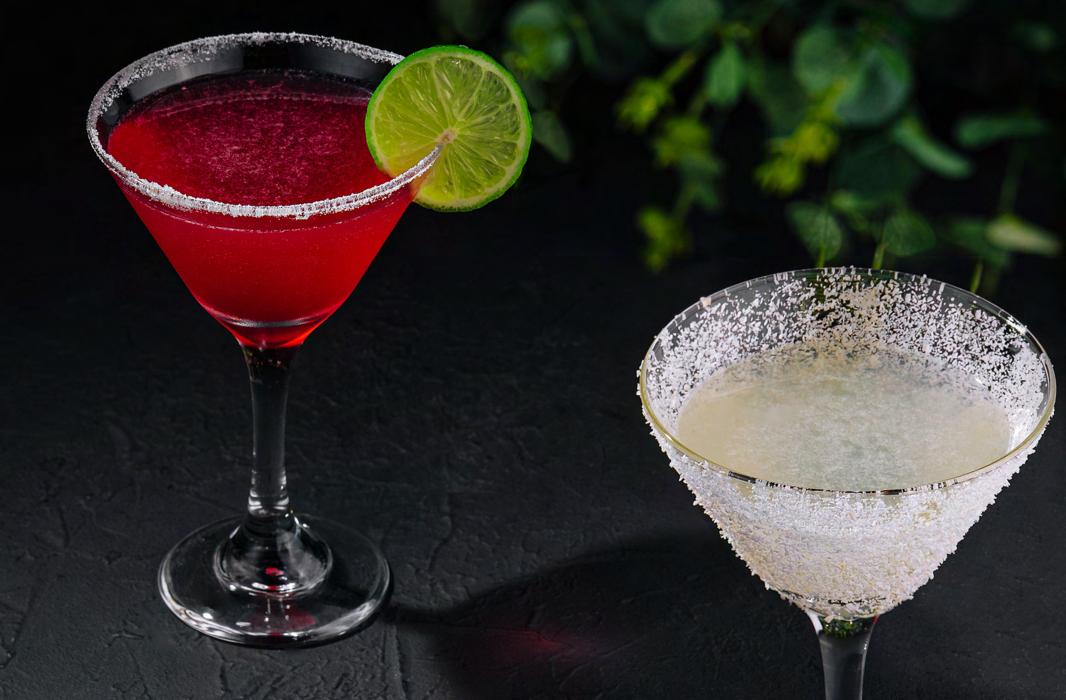

and halva crumbs. In London, you’ll find mango pickle emulsionsandgunpowderspicesprinkledoversearedtuna.
What’s powerful is how Indian ingredients are no longer boxed into Indian cuisine—they’re being embraced as flavour elements in global kitchens. There’s room now for IndianItalian,SouthIndian-Japanese,Bengali-Mediterranean. Andbehinditallisagrowingawarenessthattheseingredients carry history, geography, memory, and meaning—not just taste.
The global food scene is in flux. Diners are curious, educated, andlookingbeyondcomfortfood.There’sanopennessto:
Ÿ Trynewtextures
Ÿ Eatplant-basedmoreoften
Ÿ Valueindigenousknowledgesystems
Ÿ Celebrateculturaldiversity
Indian ingredients tick all the boxes. They're rich in heritage, complex in flavour, and endlessly versatile. Add to that their health benefits and low ecological footprint, and it’s no surprise that they’re finally being recognised—not just as exoticflair,butasbuildingblocksofcontemporarycuisine.
What started as a trend is becoming a movement of reclamation and pride. Indian chefs, especially, are no longer trying to fit into a Western mould—they’re pushing Indian ingredients forward as the new standard. They’re moving from “Indianfoodwithatwist”to“globalfood,rootedinIndia.”
This shift also allows for better representation, sourcing, and sustainability. When moringa grows in your backyard, and millet thrives without heavy irrigation, why import kale or quinoa?
As the global palate expands, Indian ingredients are finally having their moment—not as background dancers, but as lead performersontheworld’smostprestigiousstages.
Whether it’s kokum in a craft cocktail, moringa on a spa menu, or bajra in a breakfast bowl, one thing is clear: India’s food story is no longer confined to borders or tradition. It’s evolving, expanding,andinspiring.
Andattheheartofitallisasimpletruth—what’srootediswhat rises.


By Aditi Malhotra
LIQUID DESSERTS
Cocktails Inspired by Indian Sweets


Some celebrations call for a toast. Others, for dessert. But the best ones? They call for both—preferablyinthesameglass.
Welcome to the decadent, delicious world of liquid desserts—wherecocktailstaketheircuefromIndia’s most beloved sweets, creating drinks that are as indulgent as they are imaginative. Think creamy, spiced, fragrant blends that channel the essence of rasmalai, gulab jamun, gajar halwa, and even kaju katli,allshaken,stirred,andservedwithflair.
This isn’t just a gimmick. It’s a full-blown trend that’s taken hold in India’s most creative bars, from Goa’s boutique beachside spots to urban cocktail dens in Mumbai, Bangalore, and beyond. And it’s more than nostalgia—it’s about celebrating flavour, craft, and alittlebitofdrama.
THE BIRTH OF A TREND
Traditionally,dessertcocktailshavebeendefinedby Western classics—tiramisu martinis, chocolate liqueur shots, espresso and Baileys concoctions. But today, Indian palates are leaning into flavours they’ve grown up with, and bartenders are responding with inventive drinks that blend comfort withcomplexity.
Imagine the sweetness of condensed milk balanced with gin, the nuttiness of pista and saffron woven into a warm whisky cocktail, or the unmistakable rose-kewra essence of a gulab jamun transformed intoasilky,boozytreat.
And the best part? These drinks aren’t overly sugary or kitsch. The best versions are refined, layered, and deeply satisfying—like the sweets they draw inspirationfrom.
FROM MITHAI BOX TO BAR COUNTER
Here’s how some of India’s most iconic desserts are beingreimaginedascocktails:
1. Rasmalai White Russian
This smooth, indulgent blend features vodka, coffee liqueur, saffron milk, and a touch of rose water. Garnished with crushed pistachios and edible petals, it’s essentially dessert in a glass—but with a buzz.
2. Kaju Katli Sour
A play on the whisky sour, this drink uses cashew orgeat (a nutty syrup), lemon juice, bourbon, and egg white (or aquafaba for a vegan version). Velvety, rich, and beautifully balanced between sweetandtart.
3. Gajar Halwa Old Fashioned
Infused ghee-washed rum or whisky is mixed with a carrot-spice syrup and bitters. It’s warm, slightly spiced, and ideal for cooler evenings or late-night dessertsipping.
4. Jalebi Margarita
Yes, it’s a thing—and yes, it works. Tequila meets orange zest, lime juice, and a jalebi syrup reduction for a cocktail that’s bright, citrusy, and unapologeticallyfun.
COCKTAILS AND CUISINE WITH ADITI

5. Phirni Colada
A tropical-Indian mashup using coconut milk, cardamom, and rice-washed rum or dark rum. Served over crushed ice with a sprinkle of desiccated coconut and nutmeg, it’s soothing and sunnyallatonce.
WHY THESE COCKTAILS WORK
At first glance, you’d think cocktails based on mithai would be too heavy or sweet. But modern mixology is all about balance—and these drinks use texture, aromatics, and acidity to ensure they remain light, elegant,andsip-worthy.
What makes them truly shine is the emotional response they trigger. They’re rooted in nostalgia, but refined for a modern palate. You’re not just
tasting a drink—you’re remembering weddings, Diwali feasts, and stolen fridgedessertsfromchildhood.
CELEBRATING WITH LIQUID DECADENCE IN GOA
InGoa,whereeveryeveningfeelslikea reason to celebrate, dessert cocktails are becoming a post-dinner ritual. Beach bars serve chilled gulab liqueur digestifs. Boutique cafés create saffron-infused cocktails with coconut foam. And if you’re lucky, you might even spot a payasam-inspired drink at asunsetsoirée.
These aren’t just drinks. They’re talking points, memory-makers, and playful reminders that Indian flavours belong in every kind of celebration—including yourcocktailglass.
FINAL SIP
So, the next time you're planning a celebration—or just looking for something unique to end the evening—skip the second slice of cake. Orderarasmalaimartiniinstead. Orbetteryet,shakeoneupathome.All it takes is a little imagination, a few bar basics, and your favourite mithai for inspiration.





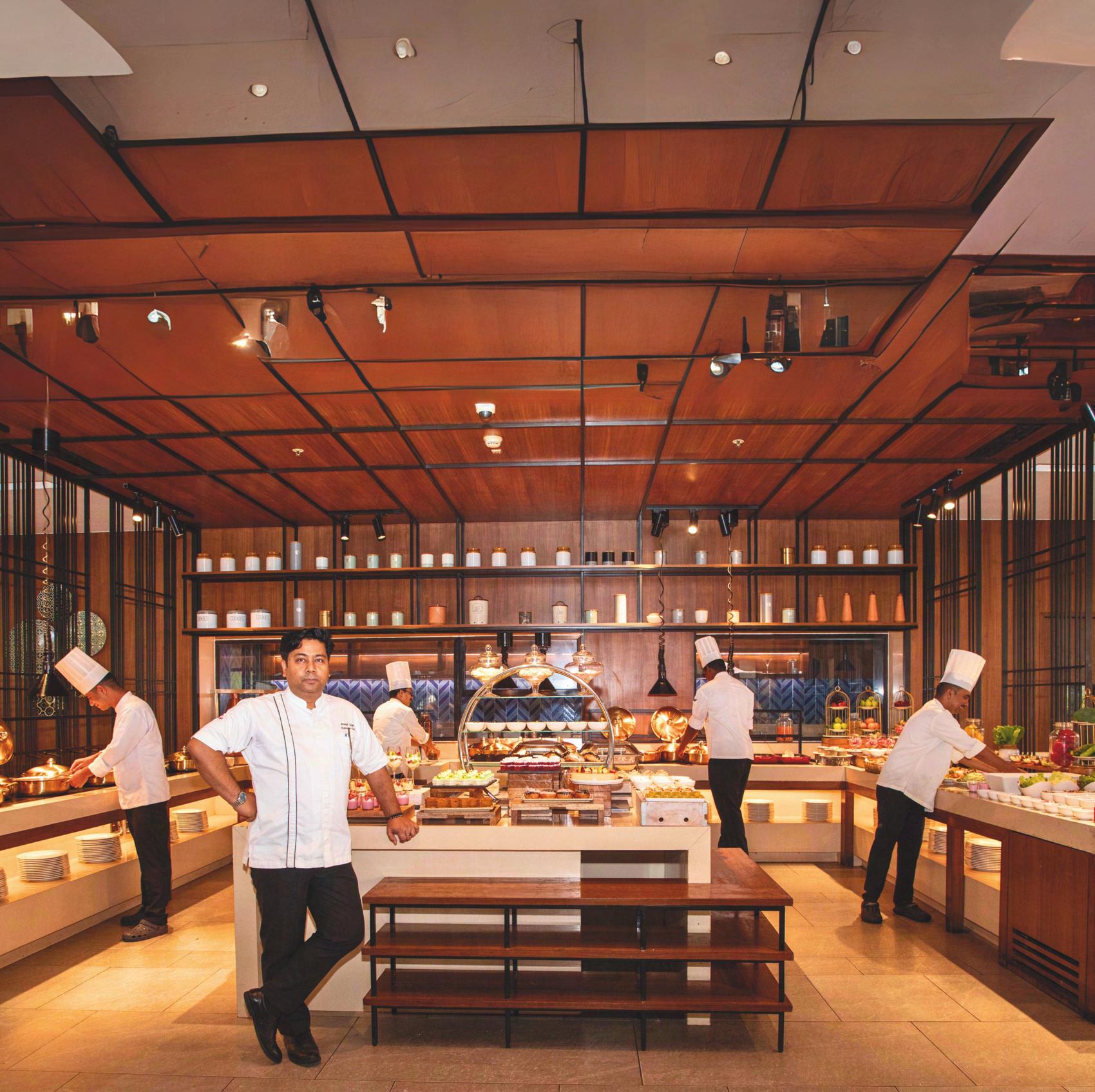


Where Green Meets Grandeur
A Regal Retreat at UK 27 The Fern, Belagavi
Sometimes, the best escapes are not in faraway lands, but in discoveringnewdimensionsofcomfortandculturejustadrive away. That's exactly what we found during our recent staycation at UK 27 The Fern, Belagavi, a five-star ecotel that seamlessly blends sophistication, sustainability, and superb hospitality.
Located in the heart of the charming city of Belagavi, just about five hours from Goa by road, UK 27 The Fern is a
revelation. This is not just a hotel stay; it's a well-scripted experience where luxury whispers rather than shouts, and every corner echoes the brand's deep commitment to consciousliving.
CHECK-IN TO ECO-CONSCIOUS EXCELLENCE
Stepping into the hotel lobby felt like entering a space where modernity meets mindfulness. Polished marble floors, fresh

floral arrangements, and the soft hum of instrumental music set the tone. Yet, what stood out wasn't just the glamour—it was the green. As an Ecotel, UK 27 The Fern takes sustainability seriously, with eco-friendly initiatives embedded intoeveryaspectofthestay.
From the use of energy-efficient lighting to eco-conscious materials,thehotelwalksthetalk.Andthebestpart?Youdon't feel like you're giving up comfort for the cause—if anything, it addstotheexperience.
A ROOM FOR EVERY MOOD, A SUITE FOR EVERY STORY
Our stay began in one of the Winter Green Premium Rooms, and we were instantly taken by the thoughtful layout, elegant furnishings, and calming colour palette. The room was spacious and equipped with all the modern-day comforts: plush bedding, a sleek work desk, a walk-in wardrobe, and a bathroom that felt spa-like with its glass shower cubicle and eco amenities.
Later, we toured the expansive Fern Club Suites and Hazel Suites, both of which were a masterclass in indulgent design. From dining spaces to Jacuzzis, these suites are perfect for those seeking a longer, more luxurious stay. Whether you're travelling for business, romance, or a personal reset, UK 27 offers a roomthatfeelsjustright.
THE HOTEL THAT SERVES ON EVERY FRONT
UK 27 The Fern isn't merely a collection of rooms, it's a complete hospitality ecosystem. Every corner of the hotel is designedtoofferanexperience.
Want to sip cappuccino while people-watching in a lobby adorned with elegant art? Head to Deli@Lobby. Want a quick detox swim with a view? The rooftop pool offers 180-degree panoramas of Belagavi's urban stretch. Looking to keep your wellness routine intact? The Curve gym is fully equipped for seriousfitnessenthusiasts.
And for events, be it corporate conferences or dreamy destination weddings, the hotel's banquet collection includes Diamond and Emerald Halls, a boardroom, and a lush 15,000 sq.ft.lawn,oneofthelargestintheregion,capableofhosting


upto1,200guestsinsheerstyle.
A CULINARY TRAIL WORTH TRAVELLING FOR
One of the standout aspects of our staycation was the diverse andmemorablefood.UK27doesn'tjustservemeals,itcurates culinaryjourneys.
We began our mornings at Mélange, the all-day dining restaurant, where a lavish breakfast spread awaited us. Fluffy idlis, masala dosas, buttery croissants, and farm-fresh juices gave us plenty to look forward to. But it's not just about breakfast—Mélange's global menu offers everything from classic Indian gravies to Mediterranean grills, all plated with finesse.
For lunch, we decided to explore Spices, their purevegetarian Indian restaurant. It was a delightful surprise—rich curries, freshly made rotis, and a thali experience that capturedregionalflavoursbeautifully.
Dinner was a special treat at Yaki, the hotel's Pan-Asian restaurant. Think sushi, Thai curries, wok-tossed noodles, and exotic mocktails. The service here was just as exceptional as the food—warm, attentive, and intuitive without being intrusive.
And for that post-meal unwind? Nothing beats the vibe at the UK Lounge rooftop resto-bar. With the city lights twinkling below, a well-crafted cocktail in hand, and the DJ spinning mellowbeats,itwastheperfectwaytowrapuptheevening.
RELAX, REJUVENATE, REPEAT
No staycation is complete without some poolside lounging, and the rooftop pool at UK 27 doesn't disappoint. Offering panoramic views of Belagavi, it's an oasis of calm, complete
with sunbeds and a poolsidesnackmenu. For fitness enthusiasts, the hotel's gym is wellequipped and userfriendly, perfect for a quick workout before a hearty breakfast. And if relaxation is your mantra, simply laze in the hotel's lush green 15,000 sq. ft. lawn, which doubles up as a magical space for weddingsandevents.
STEP OUTSIDE AND DISCOVER BELAGAVI
Whilethehotelisaworld in itself, we couldn't resist exploring the cultural gems nearby. Within minutes, we were at the Belagavi Fort, marvelling at ancient walls steeped in Maratha and British history. A short drive led us to the breathtaking Gokak Falls, often called the "Niagara of Karnataka", especially stunning duringthemonsoons.
We also took a detour to the Jamboti Hills, ideal for trekking and nature trails. The concierge at UK 27 helped us plan our mini-excursion with maps, car bookings, and personal recommendations. The accessibility of the hotel to such attractions makes it a perfect base for both staycationers and explorers.
A STAY, THAT STAYS WITH YOU
As we prepared to leave UK 27 The Fern, there was a quiet pause in the air—the kind you feel when you know you've experienced something special. This wasn't just another hotel visit;itwasararealignmentofthoughtfulness,taste,andtime. In a world that's constantly rushing, this five-star Ecotel reminds you to slow down. To savour your morning coffee not for the caffeine, but for the calm. To taste each bite like it tells astory.Toopenyourcurtainsnotjusttoaview,buttotheluxury ofstillness.
UK 27 The Fern doesn't just offer a stay. It offers space to breathe, reasons to feel, and a new lens through which to see luxury, not as extravagance, but as experience. One that nourishes, not just entertains. One that respects the Earth, whileelevatingtheguest.
So, if your soul is craving something deeper than a getaway—something graceful, grounded, and grand—let it finditswayhere.
Because at UK 27 The Fern, Belagavi, you don't just check in to a hotel. You check in to a way of life.

What to Eat for That Summer Glow FOOD FOR SKIN HEALTH
By Sunil Malhotra


Because good skin doesn’t start at the salon—it starts on your plate
Come summer, our skincare routines often shift into overdrive. We invest in gels over creams, reach for that SPF religiously, and try to avoid the sun at its peak. But while serums and sunscreen do their bit on the outside, the real, lasting glow comes from within—from the nutrients we feed our bodies, day afterday.
Your skin is your largest organ, and it reflects the story of your internal health. Dehydration, poor digestion, excess sugar, or nutritional deficiencies all show up first on your face—as dullness, breakouts, patchiness, or premature lines. And with Goa’s rising humidity, exposure to salty air, and longer days outdoors, supporting your skin through food becomes more essentialthanever.
Here’s how to eat in a way that not only cools your body but keeps your skinsupple,nourished,andradiating withnaturalglow—nofilterrequired.
EAT THE RAINBOW,
LITERALLY
Colour on your plate translates to antioxidants in your bloodstream. Red, yellow, orange, green, purple—these pigments are powerful indicators of skin-loving nutrients.
Ÿ Carrots, mangoes, papaya, and pumpkin: Rich in betacarotene, which converts to vitamin A and helps repair sun damage.
Ÿ Beetroot and berries: Packed with anthocyanins, these support collagen production and fight freeradicaldamage.
Ÿ Spinach and amaranth leaves: Loaded with vitamin C,
iron, and folate, which boost skin healing and blood circulation.
Eating a variety of colours ensures that you’re getting a wide spectrum of micronutrients, which work synergistically to protectandrestoreskin.
HEALTHY FATS = HAPPY SKIN
If your skin is feeling dry, inflamed, or prematurely ageing, chances are it’s craving fat—not just any fat, but the right kinds.
Ÿ Coconut and its oil: A Goan staple, coconut supports skin elasticity and hydration. Use it in cooking or sip on coconut waterdaily.
Ÿ Nuts and seeds (almonds, walnuts, flax, chia): Provide omega-3 fatty acids, which reduce inflammation and

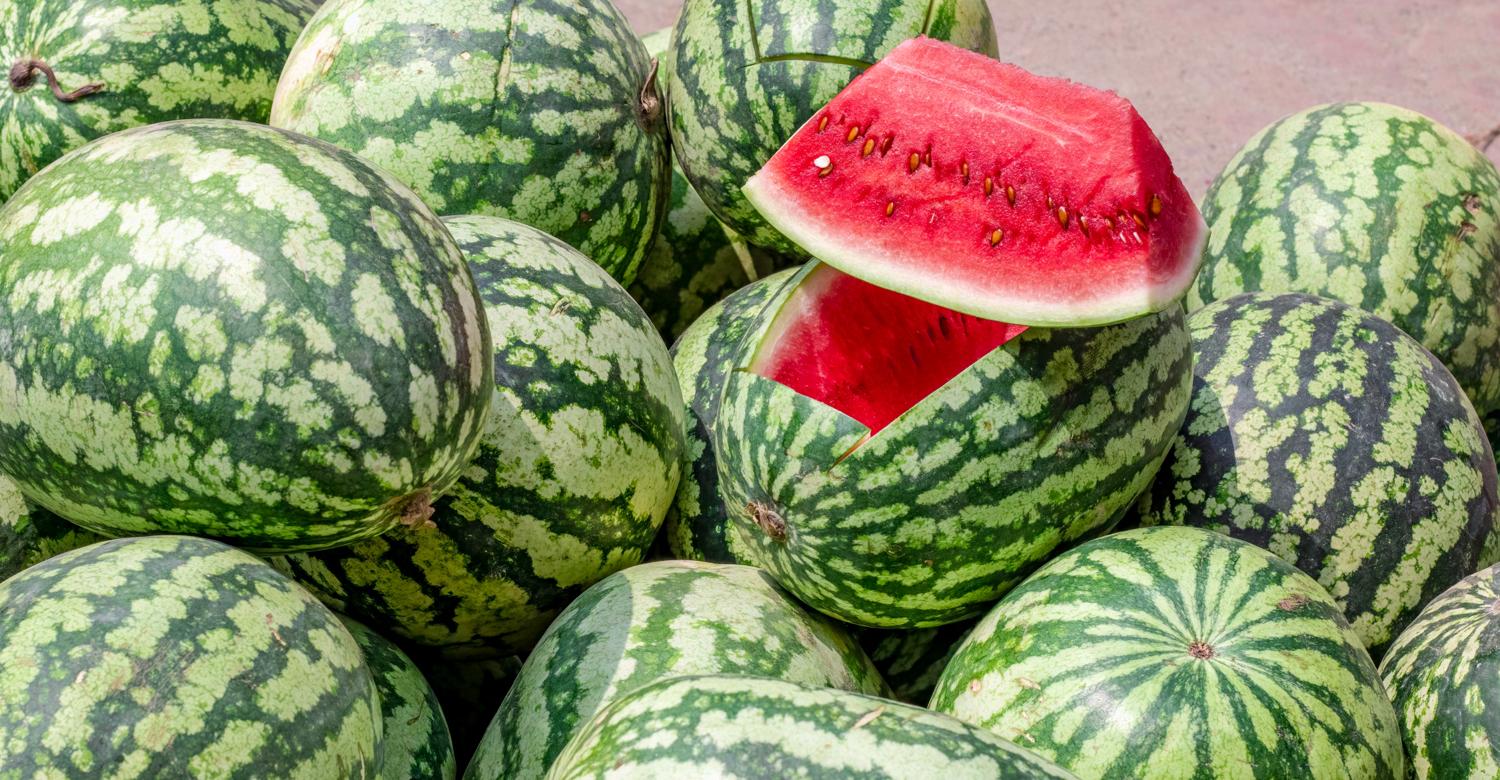
supporttheskinbarrier.
Ÿ Avocados: High in both vitamin E and monounsaturated fats, these help protect against oxidative damage and sun stress.
Incorporating healthy fats helps maintain the lipid barrier of the skin, which is crucial for moisture retention—especially in summer.
HYDRATION HEROES
Glowing skin is well-hydrated skin, and hydration doesn’t comefromwateralone—italsocomesfromwhatyoueat.
Ÿ Cucumbers, watermelon, muskmelon: These highwater-content fruits help maintain skin elasticity and detoxifythesystem.
Ÿ Kokum and buttermilk: Both cooling and gut-friendly, they help regulate internal temperature and reduce heatinducedskinflare-ups.
Ÿ Herbal teas with mint or fennel: Promote digestion, whichisdirectlylinkedtoclearskin.
Avoid excessive caffeine or alcohol, which dehydrate the skin andcanleadtodullnessorpuffiness.
POWER NUTRIENTS TO PRIORITISE
Ÿ Vitamin C: Essential for collagen production and skin repair.Foundinamla,citrusfruits,guava,capsicum.
Ÿ Zinc: Regulates oil production and helps with acne healing.Foundinpumpkinseeds,lentils,andchickpeas.
Ÿ Selenium: A skin-protective antioxidant found in sunflowerseedsandwholegrains.
Ÿ Biotin: Popular in hair and skin supplements but also naturallypresentineggs,sweetpotatoes,andpeanuts. Rather than relying on pills and powders, the focus should be
onadiverse,nutrient-richplatethatfeedsyourskineveryday.
SKIN-SMART SUMMER HABITS
Ÿ Start your day with soaked almonds or a spoon of ghee—itsetsthetoneforbetterskinanddigestion.
Ÿ Avoid excess sugar—it accelerates collagen breakdown andcausesinflammation.
Ÿ Don’t skip meals—especially in summer, as low blood sugar leads to stress and oil imbalances that show up on yourskin.
Ÿ Incorporate raw salads or lightly steamed veggies in atleastonemealdailyforenzymesandfiber.
THE SKIN-GUT-STRESS CONNECTION
Emerging science has shown us the powerful link between gut health and skin health. If your gut is inflamed or sluggish, your skin may manifest it in the form of acne, eczema, or dullness. Likewise, chronic stress can spike cortisol, leading to breakoutsandincreasedoiliness.
A balanced diet, with a focus on prebiotics (garlic, bananas, onions) and probiotics (curd, kanji, pickles) can greatly improvenotjustdigestionbutalsoskinclarityandtexture.
FINAL THOUGHT: EAT LIKE YOU WANT TO GLOW
Your skin is a mirror of your internal health. Instead of chasing superficial fixes, nourish your skin with whole, seasonal, real food—because beauty isn’t something you apply. It’s somethingyouabsorb,chew,digest,andreflect. So go ahead. Add that extra spoon of ghee, blend in those greens, sip your kokum, and eat like you mean it. Your skin will thankyou.

How to Eat Between Meals Without Guilt MINDFUL SNACKING
By Sunil Malhotra


Becauseit'snotabouteatingless—it'sabouteatingsmarter
We've all been there. The clock strikes 4 PM, lunch feels like a distant memory, and dinner is too far away to wait. Or it's midnight, and suddenly your kitchen lights feel more welcoming than your bed. And yet, somewhere along the way, snacking got labelled as the villain in every “clean eating” narrative—something to be ashamed of, controlled, or cut outaltogether.
But here's the truth: snacking isn't the problem. Mindless snacking is. When done intentionally, snacking can actually support your energy levels,balanceyourmood,and keep your metabolism functioning optimally. It's all about making better choices, notrigidrules.
WHY WE SNACK (AND WHY THAT'S OKAY)
Snacking gets a bad rap because we often associate it with boredom, stress-eating, or impulsive choices—a bag of chips here, a chocolate bar there, mindlessly eaten in front ofascreen.Butthebodysends genuine hunger cues between meals for valid reasons—especiallyif:
Ÿ You had a light or early lunch
Ÿ You're more physically active
Ÿ You're on your period or ovulating (hello, cravings!)
Ÿ Your blood sugar levels are dipping Rather than suppress those needs or ignore them in the name

FOOD & HEALTH

of"discipline,"whatifwejustrespondedmoremindfully?
THE KEY IS IN THE CHOICE
Amindfulsnackisonethat:
Ÿ Satisfies hunger, not just cravings
Ÿ Supports energy without leading to a crash
Ÿ Nourishes, even in small quantities
Ÿ Feels good, physically and mentally That doesn't mean snacks have to be picture-perfect or exotic. It means building habits around what works for your lifestyle,schedule,andpreferences.
MINDFUL SNACKING IN REAL LIFE: PRACTICAL IDEAS THAT WORK
1. Pair protein and fiber – This duo keeps you full and slows sugarspikes.
Ÿ Try: An apple with peanut butter, roasted chana with a squeezeoflime,orhummuswithveggiesticks.
2. Keep it seasonal – Summer fruits like watermelon, muskmelon, and lychee make for refreshing low-calorie snacks.
Ÿ Addasprinkleofchaatmasalaforthatsatisfyingkick.
3. Don't fear healthy fats – Nuts, seeds, and coconut are all greatsourcesofsatiety.
Ÿ Try a small trail mix with almonds, raisins, sunflower seeds, anddriedapricot.
4. Think beyond the packet –Ready-to-eatsnacksarefinein moderation,buttryswappingthehabitwithsmallprepideas:
Ÿ Boiled eggs with pepper
Ÿ Air-fried makhana tossed in olive oil and turmeric
Ÿ Leftover sabzi rolled in a whole wheat roti 5. Make it an occasion, not a reflex – Avoid eating directly from a packet, or while scrolling on your phone. Plate it, sit down, and give it your attention—even if it's just fiveminutes.
SNACKS THAT SNEAK IN TROUBLE
Not all snacks are created equal. Here are some that may feel satisfying in the moment, but come with a crash:
Ÿ Refined flour biscuits and crackers
Ÿ Sugar-loaded "health" bars
Ÿ Fried chips and mixtures
Ÿ Sugar-sweetened yogurt cups
Ÿ Juices that seem healthy but are mostly fructose bombs
These aren't forbidden—but if you find yourself reaching for them daily, it might be worth exploring what you're really hungryfor:energy?comfort?crunch?sweetness?
SNACKING IN GOA: A LOCALISED APPROACH
Living in or visiting Goa gives you the gift of fresh, local, and minimallyprocessedoptions.Think:
Ÿ Tender coconut water with the malai scooped right out
Ÿ Lightly salted boiled groundnuts on the go
Ÿ Roasted corn with lime and chilli
Ÿ Raw mango slices in season with a dash of black salt When you work with what's around you, snacking becomes a naturalextensionoftheenvironment—andfarmoreenjoyable.
THE BIGGER PICTURE: IT'S ABOUT BALANCE
Mindful snacking is not about being “good” or “bad.” It's about tuning into your body and choosing foods that support you without guilt. Some days that's a fruit bowl. Some days it's chocolate. What matters is the why and the how, not just the what.
Because the goal isn't perfection—it's peace. And that, in the end, is the most nourishing thing you can give yourself.


SEAWEED FARMING A SUSTAINABLE SUPERFOOD AND CLIMATE SOLUTION?
By Niharika Sachdeva
INTRODUCTION TO SEAWEED FARMING
Seaweed, often found floating beneath the ocean's surface, has long been a critical resource for coastal communities worldwide. Now, in the face of climate change, food insecurity, and environmental degradation, seaweed is making a comeback—not just as a food source, but as a powerfultoolforsustainability.Seaweedfarming,orseaweed aquaculture,involvescultivatingvarioustypesofmarinealgae
in shallow waters using ropes or nets suspended between buoys. Unlike traditional crops, seaweed does not require soil, freshwater, or fertilizers. It draws all its nutrients from the ocean, grows rapidly, and helps improve water quality. These traits make seaweed an environmentally friendly crop with vastpotential.
THE NUTRITIONAL BENEFITS OF SEAWEED

Seaweed is a nutritional powerhouse. Packed with iodine, iron, calcium, magnesium, and vitamins A, C, E, and K, it also contains antioxidants, fiber, and plant-based protein. This makes it an appealing ingredient for health-conscious consumers seeking sustainable diets. In recent years, seaweedhasgainedpopularityinWesternmarkets,especially among those adopting plant-based diets. From sushi to snacks, and even seaweed-based meat alternatives, this once-foreignfoodisnowastapleinmanykitchensworldwide.
In India, seaweed is starting to find a place in the culinary world, especially in coastal regions where it has traditionally been used in local dishes. Its nutrient profile makes it ideal for addressing malnutrition, especially in coastal communities, providing an easily accessible, plant-based source of vital nutrients.
SEAWEED AS A CLIMATE SOLUTION
Seaweed's benefits extend beyond the dinner plate. As it grows, it absorbs large amounts of carbon dioxide through photosynthesis, helping reduce the amount of greenhouse gases in the atmosphere. This process also aids in combating ocean acidification, a growing issue for marine ecosystems. Someresearcherssuggestthatseaweedfarmingcouldactas anaturalformofcarboncapture,lockingCO₂ awaybysinking harvested biomass into the deep ocean. Although the concept requires further study, the potential of seaweed to playaroleinclimatemitigationisclear.
Additionally, seaweed farming can alleviate some of the pressures caused by traditional agriculture, which requires vast amounts of freshwater, land, and synthetic fertilizers. In contrast, seaweed thrives without these resources, offering a more sustainable way to produce food and other valuable products.
ENVIRONMENTAL IMPACT: PROTECTING MARINE ECOSYSTEMS
Seaweed farming also helps maintain marine ecosystem health. By absorbing excess nitrogen and phosphorus, often causedbyagriculturalrunoff,seaweedpreventsharmfulalgal blooms that can deplete oxygen and suffocate marine life. It creates a more balanced, cleaner aquatic environment, makingitakeyplayerinmaintainingbiodiversity.
In integrated aquaculture systems, seaweed is often grown alongside shellfish like oysters and mussels, which filter water and promote a symbiotic relationship. This combination leads to a low-impact, sustainable farming model that contrasts with the often damaging practices of industrial fish farming, such as overuse of antibiotics and disruption of marine ecosystems.
SEAWEED FARMING IN INDIA: OPPORTUNITIES AND CHALLENGES
India’s long coastline provides abundant opportunities for seaweed farming. States like Tamil Nadu, Gujarat, Maharashtra, and the Andaman and Nicobar Islands have ideal conditions for growing various species of seaweed. Despite this potential, seaweed farming remains underdeveloped. However, pilot projects supported by scientific organizations such as the Central Salt and Marine Chemicals Research Institute (CSMCRI) are demonstrating its viability as a livelihood option. For many coastal communities, particularly women and small-scale fishers, seaweed farming offers a promising source of income that is less reliant on overfishing.
India’s Blue Economy initiative is pushing for the development of seaweed farming on a national scale. The government has recognized the potential of seaweed to contribute to food security, coastal economy, and environmental sustainability. However, challenges remain in the form of infrastructure development, lack of processing facilities, and limited domestic demand for seaweed-based products. To scale up this industry, further investment in research, processing technology,andconsumereducationisessential.
SUSTAINABILITY

SEAWEED AS AN INCOME SOURCE FOR COASTAL COMMUNITIES
Seaweed farming offers a significant economic opportunity, especially in coastal areas where fishing alone may no longer provide sustainable livelihoods. Low startup costs and minimal technological requirements make it accessible to small-scale farmers. Unlike traditional aquaculture, seaweed farming does not rely on antibiotics or chemical inputs, making it a moreeco-friendlyalternative.
For India’s coastal communities, especially women and marginalized groups, seaweed farming can provide a new source of income. This industry not only diversifies income streams but also supports gender equality, as women often play key roles in the farming, processing, and marketing of seaweed. With growing global demand for seaweed-based products, the sector has the potential to lift coastal economieswhileprovidingsustainableemploymentoptions.
TECHNOLOGICAL INNOVATIONS IN SEAWEED FARMING
To unlock the full potential of seaweed farming, technological innovations are crucial. Improved cultivation methods, such as better farming equipment and more efficient harvesting techniques, can increase productivity and reduce costs. Advancesinprocessingtechnologyarealsoimportant,asthey allow for the creation of a wider variety of seaweed-based products, from food to cosmetics to biodegradable packaging.
Research is also underway to develop seaweed biofuels, offering a renewable energy source that could help reduce reliance on fossil fuels. Additionally, seaweed-based fertilizers are gaining popularity as environmentally friendly alternatives to chemical fertilizers, further expanding the
marketforthisversatileplant.
THE FUTURE OF SEAWEED: SCALING FOR SUSTAINABILITY
Seaweed farming represents an opportunity to create a sustainable food system that works with nature. Unlike traditionalagriculture,whichoftenleadstodeforestation,soil depletion, and water scarcity, seaweed farming has minimal environmental impact. It can provide nutritious food, contribute to carbon capture, and support coastal communities—allwithoutcompetingforlandorfreshwater.
Scaling seaweed farming requires collaboration between governments, businesses, and local communities. Responsible policies, investment in infrastructure, and public-private partnerships are essential to grow the industry sustainably. By supporting seaweed farming, we can create a circular economy where nothing goes to waste, and every part of the plantisused,fromfoodtofueltofertilizer.
CONCLUSION: GROWING THE FUTURE IN THE OCEAN
As the world seeks climate solutions that are both scalable and sustainable, seaweed farming stands out as a natural choice. It offers a way to address pressing global issues like climate change, food insecurity, and economic development—all while protecting the environment. With continued research, support from policymakers, and a commitmenttosustainablepractices,seaweedfarmingcould become a key part of our solution to building a greener, healthierfuture.
Seaweed’s role in addressing global challenges is clear. By promoting its growth, supporting coastal communities, and developing its commercial potential, we can ensure that this powerful plant continues to contribute to a sustainable and resilientworld.


























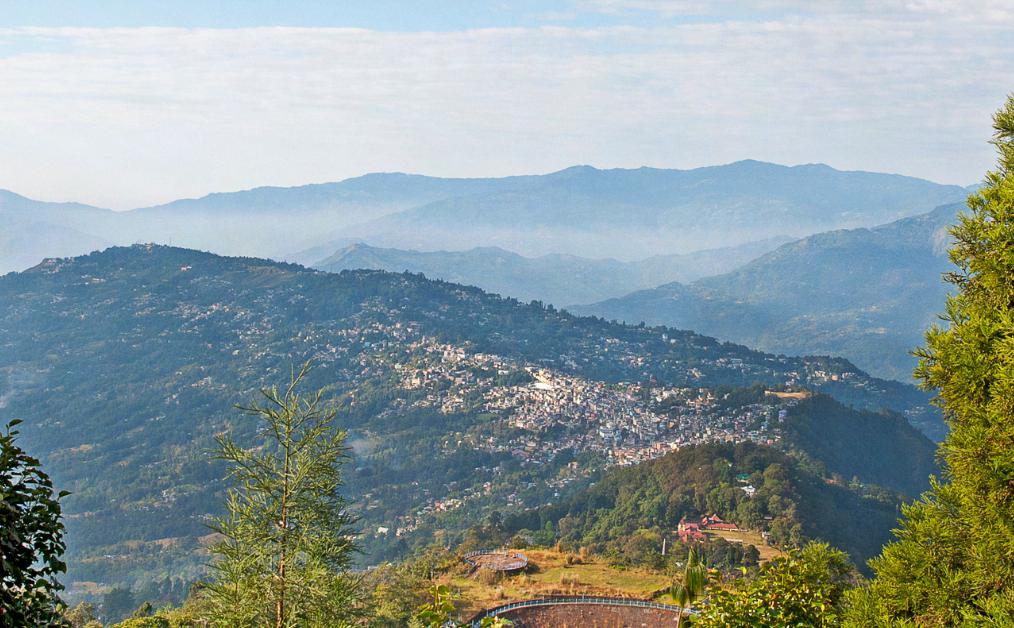
By Aditi Malhotra
EXPLORING EAST INDIA, CHAPTER 4
Kalimpong & the Art of Slow Travel in the Hills
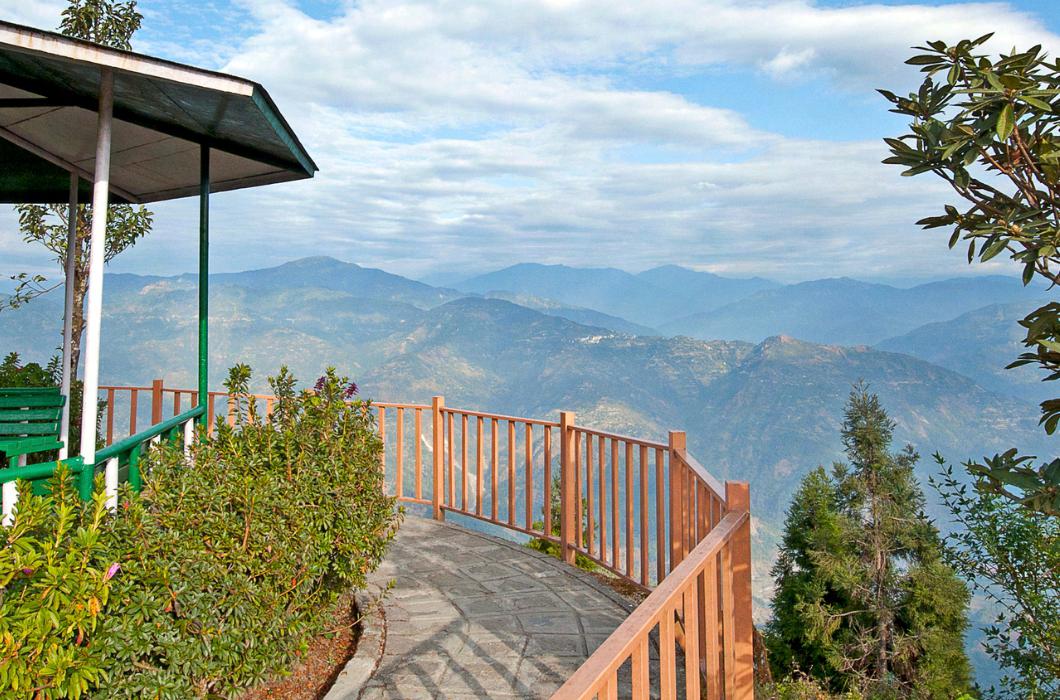
Where time pauses, orchids bloom, and stillness becomesthejourney
Hidden in the eastern Himalayan folds of West Bengal lies a town that doesn't shout for your attention—it waits for you to notice. Kalimpong, often overshadowed by its more tourist-heavy cousin Darjeeling, is the kind of place that invites you in with quiet charm and leaves you with a lingering calm. It's a hill town that offers no rush, no frenzy—only serenity, mist, and the subtle art of slowingdown.
If you're someone who seeks more than checklists and photo ops—someone who travels to feel, to reflect, and to reconnect—Kalimpong is where your soulexhales.
THE JOURNEY IN IS PART OF THE MAGIC
TheroadtoKalimpongisasscenicasthetownitself.
Whether you're winding your way up from Siliguri or coming across the hills from Darjeeling or Gangtok, thejourneyisalllushslopes,forestedbends,andthe quietrhythmofteagardens.
As you drive in, the air gets cooler, the sky opens up, and your mind begins to unclutter. There are no horns, no aggressive taxis, just the distant ringing of prayerbellsandtherustleofbamboointhebreeze.
WHERE ORCHIDS GROW WILD AND STORIES BLOOM SLOWLY
Kalimpong was once a bustling trade post on the ancient Silk Route between India and Tibet, and the town still holds remnants of that multicultural spirit. Monasteries, colonial-era cottages, Nepali kitchens, and Tibetan shops all co-exist in peaceful layers.
The town is also known as the Orchid Capital of India, with lush nurseries and flower farms tucked into every turn. The Pine View Nursery, for example, isn't just a plant lover's paradise—it's a meditative space where you can wander among rare cactus andorchidvarietieswiththesoundofdistantchurch bellsinthebackground.
Zang Dhok Palri Phodang, a hilltop monastery overlooking the Teesta valley, is another gem—serene, spiritual, and almost cinematic in the wayit'sperchedabovetheclouds.
WHERE TO STAY: HOMESTAYS WITH HEART
Kalimpong doesn't believe in luxury hotels and infinity pools. It offers something far more valuable: authenticity and warmth. Stay at a local homestay or a restored heritage home, where mornings begin with lemon tea and views of the Kanchenjunga, and dinners end with stories from your host over
TRAVEL TALES

steamingbowlsofthukpa.
Properties like Shivoni's Garden Cottage or Dungmali House don't just give you a bed—they give you a connection. A reason to sit on the porch longer, to ask questions, to learn about herbs in the backyardandpickyourownguavasforbreakfast.
FOOD: A GENTLE FUSION OF FLAVOURS AND CULTURES
Kalimpong's food is a quiet blend of Nepali, Tibetan, and Bengali influences—warm, brothy, and perfect for the chill in the air. Forget heavy restaurant menus. Here, you're more likely to find handmade momos with fermented chilli chutney, homestyle aloo-mooli curry, or soft local cheese known as churpibeingsun-driedonbalconies.
The cafes in town are equally relaxed. At Cafe Kalimpong or Art Cafe, you can expect simple, soulful plates—cheese toast, hot chocolate, and carrot cake—served with books, art, and conversationsthatstretchintotheafternoon.
THINGS TO DO (OR NOT DO)
Kalimpong isn't for those who want a packed itinerary.It'sforthewanderers,theslowwalkers,the tea-sippers.Here'showtoexperienceitbest:
Walk along the Ridge during early morning mist, watching thetownwakeup.
Visit Durpin Monastery for panoramic views and a soulstirringquiet.
Browse through Gompus bookshop, one of the oldest in town.
Spend an afternoon doing nothing at all, except listening to the birds and the rustling leaves.
There's no pressure to "see" Kalimpong. It slowly reveals itself to those who stay long enough.
WHY IT RESONATES WITH TODAY'S TRAVELLER
In an age of overstimulation, Kalimpong offers something rare: stillness. It's a place where you can take your time, savour your meals,journalinthesunlight,ornapthroughtherain without guilt. It gives you permission to unplugwithoutannouncingit.
Especially for readers in places like Goa—used to the sea's rhythm and a slower pace—Kalimpong offers a familiar kind of peace, just in a different altitude. The lush green, the kind people, the food cooked slowly over fire—all of it feels deeply grounding.
IF YOU GO
Best time: MarchtoMay,SeptembertoNovember
How to reach: Nearest airport is Bagdogra (approx.3.5–4hoursbyroad)
Travel tip: Carry layers, not just for the cold but for spontaneoushillpicnicsandmonasteryvisits.
APlaceThatLetsYouBreathe
Kalimpong isn't just a destination. It's a feeling. A gentle reminder that you don't have to always be chasing something to experience something meaningful. Sometimes, just sitting in the hills, with a book and a cup of tea, listening to your own thoughts,isthemostbeautifulkindoftravelthereis.














